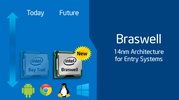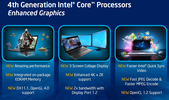Intel HD Graphics 5500 vs Intel HD Graphics 405 (Braswell) vs Intel HD Graphics 4400
Intel HD Graphics 5500 ► remove from comparison
The Intel HD Graphics 5500 (GT2) is an integrated Broadwell graphics card revealed in Q1 2015. It can be found in several ULV SoCs (15 W TDP) such as the Core i5-5200U or i7-5600U . While Core i5 and Core i7 chips feature 24 EUs, the Core i3 version offers just 23 EUs. Depending on the specific CPU, the maximum GPU frequency varies between 850 and 950 MHz.
Architecture and Features
Broadwell features a GPU based on the Intel Gen8 architecture, which has been optimized in various aspects compared to the previous Gen7.5 (Haswell). Inter alia, the shader arrays called "subslice" have been reorganized and now offer 8 Execution Units (EUs) each. Three subslices form a "slice" for a total of 24 EUs. Combined with other improvements such as larger L1 caches and an optimized frontend, the integrated GPU has become faster and more efficient than its predecessor.
The HD Graphics 5500 represents the mid-range version of the Broadwell GPU family and consists of one slice with 24 EUs. Beyond that, there is also a low-end variant (GT1, 12 EUs) as well as higher-end models (GT3/GT3e + eDRAM, 48 EUs).
All Broadwell GPUs support OpenCL 2.0 and DirectX 12 (FL 11_1) . The video engine can now decode H.265 using both fixed function hardware as well as available GPU shaders. Up to three displays can be connected via DP 1.2/eDP 1.3 (max. 3840 x 2160 @ 60 Hz) or HDMI 1.4a (max. 3840 x 2160 @ 24 Hz). HDMI 2.0, however, is not supported.
Performance
Depending on the specific CPU, the maximum GPU frequency varies between 850 and 950 MHz. Due to the low TDP, however, the average clock in 3D applications will be somewhat lower.
Equipped with fast dual-channel memory, the HD Graphics 5500 outperforms the HD Graphics 4400 (Haswell, 20 EUs) by 20 - 25 percent and also beats the HD Graphics 5000 (Haswell, 40 EUs). However, even a low-end dedicated GeForce 820M ist about 10 - 30 percent faster than the HD 5500. Games as of 2014/2015 will usually run fluently only at (very) low settings.
Power Consumption
Utilizing a new 14 nm process, the Broadwell ULV chips are specified at just 15 W TDP and therefore suited for thin ultrabooks. The TDP is flexible and can be further reduced (7.5 or 10 W), which has a significant impact on performance.
Intel HD Graphics 405 (Braswell) ► remove from comparison
The Intel HD Graphics 405 (Braswell) is an integrated graphics card in the low end SoCs of the Braswell series (e.g. Pentium N3710 ). It is based on the same architecture as the integrated GPU of the Broadwell graphics cards (e.g. HD Graphics 5300 ), but offers less shader cores and slower clock speeds.
The GPU was simply called Intel HD Graphics (Broadwell) before 2016 and included also the slower 12 EUs version in the Celeron model. The Graphics 405 name currently only stands for 16-core-versions in Pentium models. The 12 EU version is now called Intel HD Graphics 400.
The clock speed and memory configuration can still vary from model to model.
Gaming performance ist still only suited for older or less demanding games. Often also the processor is limited gaming performance (e.g. in the dual-core N3000).
The SoC also integrates a video decoding engine that should be able to handle 4K H.265 videos.
Intel HD Graphics 4400 ► remove from comparison
The Intel HD Graphics 4400 (GT2) is a processor graphics card included in some of the ULV Haswell processors of 2013. The relatively low base clock can be automatically overclocked using Turbo Boost technology. Depending on the processor model, the turbo clock rates may differ, resulting in varying graphics performance between models.
In comparison to the HD 4000, the HD 4400 graphics core has been modified extensively. The GPU now supports DirectX 11.1, OpenCL 1.2 and OpenGL 4.0. It also features an improved decoder for 4K videos and the fast Quick Sync encoder. Compared to the faster 4600, the 4400 offers the same amount of shaders, but lower clock speeds (see table of clock speeds of the different CPU models below).
The performance of the HD Graphics 4400 is somewhat below the HD 4600 , since the GPU is designed for ULV models. Therefore, the clock rates are relatively low. Furthermore, the reduced TDP limits the Turbo Boost. Compared to the ULV versions of the Ivy Bridge HD 4000 , the HD 4400 is about 20 - 30 percent faster. This performance boost is achieved by architectural improvements and an increased number of execution units: The GT2 version integrates 20 EUs, compared to 16 EUs for the old HD 4000. Depending on the clock rate, the HD 4400 matches the performance of a dedicated Radeon HD 7550M .
Due to the 22nm 3D Tri-Gate production process, the power consumption is relatively low. The HD Graphics 4400 can be found on ULV dual-core Haswell models with a TDP of 15 watts.
Intel HD Graphics 5500 Intel HD Graphics 405 (Braswell) Intel HD Graphics 4400 HD Graphics Series Codename Broadwell GT2 Braswell Haswell GT2 Architecture Gen. 8 Broadwell Gen. 8 Gen. 7.5 Haswell Pipelines 24 - unified 16 - unified 20 - unified Core Speed 300 - 950 (Boost) MHz 320 - 700 (Boost) MHz 200 - 1100 (Boost) MHz Memory Bus Width 64/128 Bit 64/128 Bit 64/128 Bit Shared Memory yes yes yes API DirectX 12 (FL 11_1), OpenGL 4.3 DirectX 11.2, Shader 5.0 DirectX 11.1, Shader 5.0, OpenGL 4.0 Transistors 1.3 Billion technology 14 nm 14 nm 22 nm Features Quick Sync QuickSync Date of Announcement 05.01.2015 01.04.2016 05.06.2013
CPU in HD Graphics 5500 GPU Base Speed GPU Boost / Turbo Intel Core i7-5600U 2 x 2600 MHz, 15 W 300 MHz 950 MHz Intel Core i7-5500U 2 x 2400 MHz, 15 W 300 MHz 950 MHz Intel Core i5-5300U 2 x 2300 MHz, 15 W 300 MHz 900 MHz » show 5 more Intel Core i5-5200U 2 x 2200 MHz, 15 W 300 MHz 900 MHz Intel Core i3-5020U 2 x 2200 MHz, 15 W 300 MHz 900 MHz Intel Core i3-5010U 2 x 2100 MHz, 15 W 300 MHz 900 MHz Intel Core i3-5015U 2 x 2100 MHz, 15 W 300 MHz 850 MHz Intel Core i3-5005U 2 x 2000 MHz, 15 W 300 MHz 850 MHz min. - max. 300 MHz 850 - 950 MHz
CPU in HD Graphics 405 (Braswell) GPU Base Speed GPU Boost / Turbo Intel Pentium N3710 4 x 1600 MHz, 6 W 400 MHz 700 MHz Intel Atom x7-Z8750 4 x 1600 MHz 400 MHz 600 MHz min. - max. 300 - 400 MHz 600 - 950 MHz
CPU in HD Graphics 4400 GPU Base Speed GPU Boost / Turbo Intel Core i7-4600U 2 x 2100 MHz, 15 W 200 MHz 1100 MHz Intel Core i7-4510U 2 x 2000 MHz, 15 W 200 MHz 1100 MHz Intel Core i7-4500U 2 x 1800 MHz, 15 W 200 MHz 1100 MHz » show 10 more Intel Core i5-4310U 2 x 2000 MHz, 15 W 200 MHz 1100 MHz Intel Core i5-4300U 2 x 1900 MHz, 15 W 200 MHz 1100 MHz Intel Core i5-4210U 2 x 1700 MHz, 15 W 200 MHz 1000 MHz Intel Core i5-4200U 2 x 1600 MHz, 15 W 200 MHz 1000 MHz Intel Core i3-4120U 2 x 2000 MHz, 15 W 200 MHz 1000 MHz Intel Core i3-4030U 2 x 1900 MHz, 15 W 200 MHz 1000 MHz Intel Core i3-4025U 2 x 1900 MHz, 15 W 200 MHz 950 MHz Intel Core i3-4100U 2 x 1800 MHz, 15 W 200 MHz 1000 MHz Intel Core i3-4010U 2 x 1700 MHz, 15 W 200 MHz 1000 MHz Intel Core i3-4005U 2 x 1700 MHz, 15 W 200 MHz 950 MHz min. - max. 200 - 400 MHz 600 - 1100 MHz
Benchmarks Performance Rating - 3DMark 11 + Fire Strike + Time Spy - HD Graphics 5500
0.3 pt (1%)
...
...
max:
Performance Rating - 3DMark 11 + Fire Strike + Time Spy - HD Graphics 405 (Braswell)
0.1 pt (0%)
Intel HD Graphics 405 (Braswell)
...
max:
Performance Rating - 3DMark 11 + Fire Strike + Time Spy - HD Graphics 4400
0.3 pt (1%)
...
...
max:
3DMark - 3DMark Time Spy Score
289 Points (1%)
3DMark - 3DMark Time Spy Graphics
255 Points (1%)
3DMark - 3DMark Ice Storm Unlimited Graphics
min: 43391 avg: 58343 median: 58776 (7%) max: 68877 Points
min: 19812 avg: 23763 median: 23763 (3%) max: 27714 Points
37082 Points (4%)
3DMark - 3DMark Ice Storm Extreme Graphics
min: 27084 avg: 33172 median: 31022.5 (4%) max: 40670 Points
min: 12601 avg: 14069 median: 14068.5 (2%) max: 15536 Points
min: 19943 avg: 25546 median: 24573 (3%) max: 33095 Points
3DMark - 3DMark Cloud Gate Score
min: 3351 avg: 4777 median: 4790.5 (5%) max: 6106 Points
min: 1743 avg: 2000 median: 1933 (2%) max: 2392 Points
min: 1733 avg: 3980 median: 3940 (4%) max: 4989 Points
3DMark - 3DMark Cloud Gate Graphics
min: 4571 avg: 5864 median: 5544 (1%) max: 7789 Points
min: 1767 avg: 2206 median: 2113 (1%) max: 2831 Points
min: 1946 avg: 5040 median: 4953 (1%) max: 6547 Points
3DMark - 3DMark Fire Strike Standard Score
min: 500 avg: 648 median: 634.5 (1%) max: 868 Points
min: 216 avg: 237.5 median: 237.5 (0%) max: 259 Points
min: 352 avg: 543 median: 525 (1%) max: 700 Points
3DMark - 3DMark Fire Strike Standard Graphics
min: 535 avg: 694 median: 663 (1%) max: 927 Points
min: 231 avg: 254.5 median: 254.5 (0%) max: 278 Points
min: 369 avg: 592 median: 569 (1%) max: 778 Points
3DMark - 3DMark Ice Storm Graphics
min: 33288 avg: 50089 median: 48637 (6%) max: 70409 Points
min: 26056 avg: 28119 median: 28119 (3%) max: 30182 Points
min: 12866 avg: 38629 median: 38886.5 (5%) max: 58126 Points
3DMark 11 - 3DM11 Performance Score
min: 758 avg: 1088 median: 1079.5 (1%) max: 1434 Points
min: 451 avg: 523 median: 537 (1%) max: 565 Points
min: 460 avg: 843 median: 828 (1%) max: 1032 Points
3DMark 11 - 3DM11 Performance GPU
min: 667 avg: 979 median: 979 (1%) max: 1265 Points
min: 408 avg: 469.1 median: 473 (0%) max: 496 Points
min: 399 avg: 755 median: 735.5 (1%) max: 962 Points
3DMark Vantage + Intel HD Graphics 5500 3DMark Vantage - 3DM Vant. Perf. total
min: 3574 avg: 4501 median: 4798 (1%) max: 5124 Points
3DM Vant. Perf. total + Intel HD Graphics 405 (Braswell)
2081 Points (1%)
3DM Vant. Perf. total + Intel HD Graphics 4400
min: 2450 avg: 3559 median: 3583 (1%) max: 4820 Points
3DM Vant. Perf. GPU no PhysX + Intel HD Graphics 5500 3DMark Vantage - 3DM Vant. Perf. GPU no PhysX
min: 3057 avg: 3804 median: 3987 (2%) max: 4351 Points
3DM Vant. Perf. GPU no PhysX + Intel HD Graphics 405 (Braswell)
1730 Points (1%)
3DM Vant. Perf. GPU no PhysX + Intel HD Graphics 4400
min: 2083 avg: 3005 median: 2986.5 (2%) max: 4123 Points
3DMark 2001SE - 3DMark 2001 - Standard
20486 Points (21%)
3DMark 03 - 3DMark 03 - Standard
min: 9129 avg: 12378 median: 13244 (7%) max: 16040 Points
3DMark 05 - 3DMark 05 - Standard
min: 6313 avg: 8674 median: 8802 (10%) max: 10495 Points
3DMark 06 3DMark 06 - Standard 1280x1024 + Intel HD Graphics 5500
min: 5458 avg: 6875 median: 6998 (9%) max: 7950 Points
3DMark 06 - Standard 1280x1024 + Intel HD Graphics 405 (Braswell)
min: 2274 avg: 2920 median: 2920 (4%) max: 3566 Points
3DMark 06 - Standard 1280x1024 + Intel HD Graphics 4400
min: 4074 avg: 5110 median: 5164 (7%) max: 6293 Points
3DMark 06 - Standard 1280x800 + Intel HD Graphics 5500
7725 Points (10%)
Unigine Heaven 3.0 - Unigine Heaven 3.0 DX 11
9.3 fps (3%)
min: 6.5 avg: 7.7 median: 8.2 (3%) max: 8.4 fps
Unigine Heaven 3.0 - Unigine Heaven 3.0 OpenGL
9.8 fps (4%)
min: 7 avg: 8.2 median: 8.6 (4%) max: 9.1 fps
Unigine Heaven 2.1 - Heaven 2.1 high
min: 12.4 avg: 15.5 median: 15.7 (3%) max: 17.9 fps
7.4 fps (1%)
min: 7.9 avg: 10.9 median: 10.9 (2%) max: 15.9 fps
SPECviewperf 11 + Intel HD Graphics 5500 SPECviewperf 11 - specvp11 snx-01
min: 1.89 avg: 2.1 median: 2 (1%) max: 2.29 fps
specvp11 snx-01 + Intel HD Graphics 4400
min: 1.06 avg: 1.6 median: 1.7 (1%) max: 2.09 fps
specvp11 tcvis-02 + Intel HD Graphics 5500 SPECviewperf 11 - specvp11 tcvis-02
min: 2.42 avg: 2.6 median: 2.6 (1%) max: 2.9 fps
specvp11 tcvis-02 + Intel HD Graphics 4400
min: 1.47 avg: 2.2 median: 2.2 (1%) max: 2.94 fps
specvp11 sw-02 + Intel HD Graphics 5500 SPECviewperf 11 - specvp11 sw-02
min: 11.6 avg: 13 median: 12.5 (9%) max: 14.7 fps
specvp11 sw-02 + Intel HD Graphics 4400
min: 6.04 avg: 9.7 median: 9.6 (7%) max: 12.19 fps
specvp11 proe-05 + Intel HD Graphics 5500 SPECviewperf 11 - specvp11 proe-05
min: 2.14 avg: 2.3 median: 2.3 (3%) max: 2.53 fps
specvp11 proe-05 + Intel HD Graphics 4400
min: 1.39 avg: 1.8 median: 1.9 (2%) max: 2.28 fps
specvp11 maya-03 + Intel HD Graphics 5500 SPECviewperf 11 - specvp11 maya-03
min: 8.07 avg: 13.6 median: 14.7 (11%) max: 18.15 fps
specvp11 maya-03 + Intel HD Graphics 4400
min: 7.81 avg: 12.6 median: 12.2 (9%) max: 16.81 fps
specvp11 lightwave-01 + Intel HD Graphics 5500 SPECviewperf 11 - specvp11 lightwave-01
min: 14.7 avg: 18.4 median: 18.6 (20%) max: 21.44 fps
specvp11 lightwave-01 + Intel HD Graphics 4400
min: 9.88 avg: 13.6 median: 13.2 (14%) max: 17.4 fps
specvp11 ensight-04 + Intel HD Graphics 5500 SPECviewperf 11 - specvp11 ensight-04
min: 1.67 avg: 2.5 median: 2.6 (1%) max: 2.88 fps
specvp11 ensight-04 + Intel HD Graphics 4400
min: 1.29 avg: 1.9 median: 2 (1%) max: 2.47 fps
SPECviewperf 12 + Intel HD Graphics 5500 SPECviewperf 12 - specvp12 sw-03
min: 2.12 avg: 9.9 median: 12.3 (3%) max: 15.6 fps
specvp12 sw-03 + Intel HD Graphics 4400
min: 6.92 avg: 9.3 median: 9.3 (2%) max: 11.62 fps
specvp12 snx-02 + Intel HD Graphics 5500 SPECviewperf 12 - specvp12 snx-02
min: 1.37 avg: 2.3 median: 2.4 (0%) max: 2.7 fps
specvp12 snx-02 + Intel HD Graphics 4400 min: 1.99 avg: 2 median: 2 (0%) max: 2.08 fps
specvp12 showcase-01 + Intel HD Graphics 5500 SPECviewperf 12 - specvp12 showcase-01
min: 2.63 avg: 7 median: 4.2 (1%) max: 14.14 fps
specvp12 showcase-01 + Intel HD Graphics 4400
min: 4.19 avg: 4.3 median: 4.3 (1%) max: 4.48 fps
specvp12 mediacal-01 + Intel HD Graphics 5500 SPECviewperf 12 - specvp12 mediacal-01
min: 0.95 avg: 1.4 median: 1 (0%) max: 2.36 fps
specvp12 mediacal-01 + Intel HD Graphics 4400 min: 1.24 avg: 1.5 median: 1.5 (0%) max: 1.84 fps
specvp12 maya-04 + Intel HD Graphics 5500 SPECviewperf 12 - specvp12 maya-04
min: 2.49 avg: 6.3 median: 2.6 (1%) max: 12.31 fps
specvp12 maya-04 + Intel HD Graphics 4400
min: 2.36 avg: 2.5 median: 2.5 (1%) max: 2.54 fps
specvp12 energy-01 + Intel HD Graphics 5500 SPECviewperf 12 - specvp12 energy-01
min: 0.06 avg: 6.9 median: 0.1 (0%) max: 17.35 fps
specvp12 energy-01 + Intel HD Graphics 4400 min: 0.07 avg: 0.1 median: 0.1 (0%) max: 0.22 fps
specvp12 creo-01 + Intel HD Graphics 5500 SPECviewperf 12 - specvp12 creo-01
min: 2.49 avg: 5.7 median: 6.5 (3%) max: 8.99 fps
specvp12 creo-01 + Intel HD Graphics 4400
min: 6.08 avg: 6.6 median: 6.6 (3%) max: 7.02 fps
specvp12 catia-04 + Intel HD Graphics 5500 SPECviewperf 12 - specvp12 catia-04
min: 6.86 avg: 7.7 median: 7.1 (1%) max: 9.69 fps
specvp12 catia-04 + Intel HD Graphics 4400
min: 7.96 avg: 8.3 median: 8.3 (1%) max: 8.54 fps
Windows 7 Experience Index - Win7 Gaming graphics
min: 5.2 avg: 6.2 median: 6.5 (82%) max: 6.5 Points
Windows 7 Experience Index - Win7 Graphics
min: 5.2 avg: 5.5 median: 5.2 (66%) max: 6.5 Points
Cinebench R10 Cinebench R10 Shading (32bit) + Intel HD Graphics 5500 Cinebench R10 - Cinebench R10 Shading (32bit)
min: 3045 avg: 5408 median: 5270.5 (4%) max: 8571 Points
Cinebench R10 Shading (32bit) + Intel HD Graphics 405 (Braswell)
min: 2412 avg: 2685 median: 2753 (2%) max: 2822 Points
Cinebench R10 Shading (32bit) + Intel HD Graphics 4400
min: 4094 avg: 6063 median: 6130 (4%) max: 8532 Points
Cinebench R11.5 Cinebench R11.5 OpenGL 64 Bit + Intel HD Graphics 5500 Cinebench R11.5 - Cinebench R11.5 OpenGL 64 Bit
min: 13.54 avg: 21.2 median: 20.3 (7%) max: 35.03 fps
Cinebench R11.5 OpenGL 64 Bit + Intel HD Graphics 405 (Braswell)
min: 10.24 avg: 11.7 median: 11.7 (4%) max: 13.06 fps
Cinebench R11.5 OpenGL 64 Bit + Intel HD Graphics 4400
min: 9.45 avg: 16.8 median: 16.4 (6%) max: 24 fps
Cinebench R15 + Intel HD Graphics 5500 Cinebench R15 - Cinebench R15 OpenGL 64 Bit
min: 16.42 avg: 26.3 median: 25.4 (1%) max: 35.04 fps
Cinebench R15 OpenGL 64 Bit + Intel HD Graphics 405 (Braswell)
min: 10.3 avg: 13.8 median: 14.1 (1%) max: 15.74 fps
Cinebench R15 OpenGL 64 Bit + Intel HD Graphics 4400
min: 12.87 avg: 20.3 median: 20.4 (1%) max: 26.49 fps
Cinebench R15 OpenGL Ref. Match 64 Bit + Intel HD Graphics 5500 Cinebench R15 - Cinebench R15 OpenGL Ref. Match 64 Bit
min: 98 avg: 98 median: 98 (98%) max: 99.6 %
Cinebench R15 OpenGL Ref. Match 64 Bit + Intel HD Graphics 405 (Braswell)
min: 9 avg: 83.2 median: 98 (98%) max: 98 %
Cinebench R15 OpenGL Ref. Match 64 Bit + Intel HD Graphics 4400
min: 2.87 avg: 88.2 median: 98 (98%) max: 98 %
GFXBench - GFXBench Car Chase Offscreen
9.9 fps (1%)
GFXBench 3.1 - GFXBench Manhattan ES 3.1 Offscreen
20.3 fps (0%)
GFXBench 3.0 - GFXBench 3.0 Manhattan Offscreen
min: 26.9 avg: 32.4 median: 30.6 (2%) max: 44.6 fps
20.3 fps (1%)
16.2 fps (1%)
GFXBench (DX / GLBenchmark) 2.7 + Intel HD Graphics 5500 GFXBench (DX / GLBenchmark) 2.7 - GFXBench T-Rex HD Offscreen C24Z16
min: 60.9 avg: 70.9 median: 70.9 (1%) max: 87.6 fps
GFXBench T-Rex HD Offscreen C24Z16 + Intel HD Graphics 405 (Braswell) 41.3 fps (0%)
GFXBench T-Rex HD Offscreen C24Z16 + Intel HD Graphics 4400 min: 57 avg: 60.5 median: 60.5 (0%) max: 64 fps
Basemark GPU 1.2 - Basemark GPU 1.2 Vulkan Official Medium Offscreen 1080
105 fps (1%)
LuxMark v2.0 64Bit - LuxMark v2.0 Room GPU
min: 128 avg: 166.7 median: 149 (1%) max: 306 Samples/s
min: 56 avg: 68 median: 68 (0%) max: 80 Samples/s
min: 117 avg: 154.1 median: 150 (1%) max: 222 Samples/s
LuxMark v2.0 64Bit - LuxMark v2.0 Sala GPU
min: 134 avg: 311.5 median: 328 (1%) max: 409 Samples/s
min: 81 avg: 102.5 median: 102.5 (0%) max: 124 Samples/s
min: 143 avg: 227.5 median: 234 (0%) max: 293 Samples/s
ComputeMark v2.1 - ComputeMark v2.1 Result
min: 643 avg: 689 median: 695 (1%) max: 734 Points
min: 388 avg: 390.5 median: 390.5 (0%) max: 393 Points
min: 384 avg: 542 median: 575 (1%) max: 613 Points
Power Consumption - Furmark Stress Test Power Consumption - external Monitor *
min: 27.2 avg: 27.8 median: 27.8 (4%) max: 28.3 Watt
9.8 Watt (1%)
Power Consumption - The Witcher 3 Power Consumption - external Monitor *
26.5 Watt (4%)
Emissions Witcher 3 Fan Noise + Intel HD Graphics 5500 Emissions - Witcher 3 Fan Noise
37.5 dB(A) (60%)
Clock Speed - GPU Clock Witcher 3 ultra
898 MHz (35%)
Clock Speed - GPU Clock Speed Furmark
749 MHz (30%)
Average Benchmarks Intel HD Graphics 5500 → 100% n=22 Average Benchmarks Intel HD Graphics 405 (Braswell) → 50% n=22 Average Benchmarks Intel HD Graphics 4400 → 81% n=22
- Range of benchmark values for this graphics card
- Average benchmark values for this graphics card
* Smaller numbers mean a higher performance
1 This benchmark is not used for the average calculation
Game Benchmarks The following benchmarks stem from our benchmarks of review laptops. The performance depends on the used graphics memory, clock rate, processor, system settings, drivers, and operating systems. So the results don't have to be representative for all laptops with this GPU. For detailed information on the benchmark results, click on the fps number.
HD Graphics 4400:
9 [X] HP Probook 470 G2 G6W69EA Intel Core i7-4510U 2GHz
HD Graphics 4400
fps
100%
HD Graphics 5500:
9.4 [X] Asus F555LF-XO029H Intel Core i5-5200U 2.2GHz
HD Graphics 5500
fps
86%
HD Graphics 4400:
8.1 [X] HP Probook 470 G2 G6W69EA Intel Core i7-4510U 2GHz
HD Graphics 4400
fps
100%
HD Graphics 5500:
12.8 [X] Asus F555LF-XO029H Intel Core i5-5200U 2.2GHz
HD Graphics 5500
fps
69%
HD Graphics 4400:
8.8 [X] HP Probook 470 G2 G6W69EA Intel Core i7-4510U 2GHz
HD Graphics 4400
fps
HD Graphics 405 (Braswell):
17.8 fps
HD Graphics 405 (Braswell):
18 fps
100%
HD Graphics 5500:
29.3 fps
34%
HD Graphics 405 (Braswell):
9.9 fps
100%
HD Graphics 5500:
6.1 [X] Asus F555LF-XO029H Intel Core i5-5200U 2.2GHz
HD Graphics 5500
fps
67%
HD Graphics 4400:
4.1 [X] HP Probook 470 G2 G6W69EA Intel Core i7-4510U 2GHz
HD Graphics 4400
fps
100%
HD Graphics 5500:
10.1 [X] Asus F555LF-XO029H Intel Core i5-5200U 2.2GHz
HD Graphics 5500
fps
78%
HD Graphics 4400:
7.9 [X] HP Probook 470 G2 G6W69EA Intel Core i7-4510U 2GHz
HD Graphics 4400
fps
100%
HD Graphics 5500:
41.4 [X] Asus F555LF-XO029H Intel Core i5-5200U 2.2GHz
HD Graphics 5500
fps
61%
HD Graphics 4400:
25.3 [X] HP Probook 470 G2 G6W69EA Intel Core i7-4510U 2GHz
HD Graphics 4400
fps
100%
HD Graphics 5500:
13.9 [X] Asus F555LF-XO029H Intel Core i5-5200U 2.2GHz
HD Graphics 5500
fps
58%
HD Graphics 4400:
8 [X] HP Probook 470 G2 G6W69EA Intel Core i7-4510U 2GHz
HD Graphics 4400
fps
100%
HD Graphics 5500:
12.1 [X] Asus F555LF-XO029H Intel Core i5-5200U 2.2GHz
HD Graphics 5500
fps
61%
HD Graphics 4400:
7.4 [X] HP Probook 470 G2 G6W69EA Intel Core i7-4510U 2GHz
HD Graphics 4400
fps
100%
HD Graphics 5500:
21.4 21.5 [X] Asus F555LF-XO029H Intel Core i5-5200U 2.2GHz
HD Graphics 5500
~ 21 fps
52%
HD Graphics 4400:
11 [X] HP Probook 470 G2 G6W69EA Intel Core i7-4510U 2GHz
HD Graphics 4400
fps
HD Graphics 405 (Braswell):
23.6 fps
HD Graphics 405 (Braswell):
18 fps
HD Graphics 405 (Braswell):
13.9 fps
100%
HD Graphics 5500:
15.5 [X] Asus F555LF-XO029H Intel Core i5-5200U 2.2GHz
HD Graphics 5500
min:
13 fps, max:
17 fps
18.3 ~ 17 fps
61%
HD Graphics 4400:
10.3 [X] HP Probook 470 G2 G6W69EA Intel Core i7-4510U 2GHz
HD Graphics 4400
min:
9 fps, max:
11 fps
fps
100%
HD Graphics 5500:
14.9 [X] Asus F555LF-XO029H Intel Core i5-5200U 2.2GHz
HD Graphics 5500
fps
56%
HD Graphics 4400:
8.3 [X] HP Probook 470 G2 G6W69EA Intel Core i7-4510U 2GHz
HD Graphics 4400
fps
100%
HD Graphics 5500:
15 [X] Asus F555LF-XO029H Intel Core i5-5200U 2.2GHz
HD Graphics 5500
fps
67%
HD Graphics 4400:
10 [X] HP Probook 470 G2 G6W69EA Intel Core i7-4510U 2GHz
HD Graphics 4400
fps
100%
HD Graphics 5500:
29.5 [X] Asus F555LF-XO029H Intel Core i5-5200U 2.2GHz
HD Graphics 5500
fps
68%
HD Graphics 4400:
20 [X] HP Probook 470 G2 G6W69EA Intel Core i7-4510U 2GHz
HD Graphics 4400
fps
100%
HD Graphics 5500:
6 [X] Asus F555LF-XO029H Intel Core i5-5200U 2.2GHz
HD Graphics 5500
fps
67%
HD Graphics 4400:
4 [X] HP Probook 470 G2 G6W69EA Intel Core i7-4510U 2GHz
HD Graphics 4400
fps
100%
HD Graphics 5500:
9 [X] Asus F555LF-XO029H Intel Core i5-5200U 2.2GHz
HD Graphics 5500
fps
89%
HD Graphics 4400:
8 [X] HP Probook 470 G2 G6W69EA Intel Core i7-4510U 2GHz
HD Graphics 4400
fps
100%
HD Graphics 5500:
5 [X] Asus F555LF-XO029H Intel Core i5-5200U 2.2GHz
HD Graphics 5500
fps
80%
HD Graphics 4400:
4 [X] HP Probook 470 G2 G6W69EA Intel Core i7-4510U 2GHz
HD Graphics 4400
fps
100%
HD Graphics 5500:
19.8 [X] Asus F555LF-XO029H Intel Core i5-5200U 2.2GHz
HD Graphics 5500
fps
76%
HD Graphics 4400:
15 [X] HP Probook 470 G2 G6W69EA Intel Core i7-4510U 2GHz
HD Graphics 4400
fps
100%
HD Graphics 5500:
11.1 [X] Asus F555LF-XO029H Intel Core i5-5200U 2.2GHz
HD Graphics 5500
fps
67%
HD Graphics 4400:
7.4 [X] HP Probook 470 G2 G6W69EA Intel Core i7-4510U 2GHz
HD Graphics 4400
fps
100%
HD Graphics 5500:
20 [X] Asus F555LF-XO029H Intel Core i5-5200U 2.2GHz
HD Graphics 5500
fps
75%
HD Graphics 4400:
15 [X] HP Probook 470 G2 G6W69EA Intel Core i7-4510U 2GHz
HD Graphics 4400
fps
100%
HD Graphics 5500:
17.1 [X] Asus F555LF-XO029H Intel Core i5-5200U 2.2GHz
HD Graphics 5500
fps
61%
HD Graphics 4400:
10.4 [X] HP Probook 470 G2 G6W69EA Intel Core i7-4510U 2GHz
HD Graphics 4400
fps
100%
HD Graphics 5500:
44.6 [X] Asus F555LF-XO029H Intel Core i5-5200U 2.2GHz
HD Graphics 5500
fps
65%
HD Graphics 4400:
28.8 [X] HP Probook 470 G2 G6W69EA Intel Core i7-4510U 2GHz
HD Graphics 4400
fps
HD Graphics 4400:
10.3 [X] HP Probook 470 G2 G6W69EA Intel Core i7-4510U 2GHz
HD Graphics 4400
fps
100%
HD Graphics 5500:
12.2 [X] Asus F555LF-XO029H Intel Core i5-5200U 2.2GHz
HD Graphics 5500
fps
75%
HD Graphics 4400:
9.2 [X] HP Probook 470 G2 G6W69EA Intel Core i7-4510U 2GHz
HD Graphics 4400
fps
100%
HD Graphics 5500:
9.5 [X] Asus F555LF-XO029H Intel Core i5-5200U 2.2GHz
HD Graphics 5500
fps
75%
HD Graphics 4400:
7.1 [X] HP Probook 470 G2 G6W69EA Intel Core i7-4510U 2GHz
HD Graphics 4400
fps
100%
HD Graphics 5500:
13.4 [X] Asus F555LF-XO029H Intel Core i5-5200U 2.2GHz
HD Graphics 5500
fps
75%
HD Graphics 4400:
10.1 [X] HP Probook 470 G2 G6W69EA Intel Core i7-4510U 2GHz
HD Graphics 4400
fps
HD Graphics 5500:
0 (!) [X] Asus F555LF-XO029H Intel Core i5-5200U 2.2GHz
HD Graphics 5500
fps
HD Graphics 4400:
4 [X] HP Probook 470 G2 G6W69EA Intel Core i7-4510U 2GHz
HD Graphics 4400
fps
100%
HD Graphics 5500:
7 [X] Asus F555LF-XO029H Intel Core i5-5200U 2.2GHz
HD Graphics 5500
fps
71%
HD Graphics 4400:
5 [X] HP Probook 470 G2 G6W69EA Intel Core i7-4510U 2GHz
HD Graphics 4400
fps
100%
HD Graphics 5500:
42.9 (!) [X] Asus F555LF-XO029H Intel Core i5-5200U 2.2GHz
HD Graphics 5500
fps
71%
HD Graphics 4400:
30.4 [X] HP Probook 470 G2 G6W69EA Intel Core i7-4510U 2GHz
HD Graphics 4400
fps
100%
HD Graphics 5500:
10 [X] Asus F555LF-XO029H Intel Core i5-5200U 2.2GHz
HD Graphics 5500
fps
70%
HD Graphics 4400:
7 [X] HP Probook 470 G2 G6W69EA Intel Core i7-4510U 2GHz
HD Graphics 4400
fps
HD Graphics 5500:
0 (!) [X] HP 250 G5 i3-5005U MX500 Intel Core i3-5005U 2GHz
HD Graphics 5500
fps
100%
HD Graphics 5500:
19 [X] Asus F555LF-XO029H Intel Core i5-5200U 2.2GHz
HD Graphics 5500
fps
63%
HD Graphics 4400:
12 [X] HP Probook 470 G2 G6W69EA Intel Core i7-4510U 2GHz
HD Graphics 4400
fps
100%
HD Graphics 5500:
8.9 [X] Asus F555LF-XO029H Intel Core i5-5200U 2.2GHz
HD Graphics 5500
fps
89%
HD Graphics 4400:
7.9 [X] HP Probook 470 G2 G6W69EA Intel Core i7-4510U 2GHz
HD Graphics 4400
fps
100%
HD Graphics 5500:
14.3 [X] Asus F555LF-XO029H Intel Core i5-5200U 2.2GHz
HD Graphics 5500
fps
48%
HD Graphics 4400:
6.9 [X] HP Probook 470 G2 G6W69EA Intel Core i7-4510U 2GHz
HD Graphics 4400
fps
HD Graphics 405 (Braswell):
0 (!) [X] Teclast Tbook 16 Power Intel Atom x7-Z8750 1.6GHz
HD Graphics 405 (Braswell)
fps
100%
HD Graphics 5500:
11 [X] Asus F555LF-XO029H Intel Core i5-5200U 2.2GHz
HD Graphics 5500
fps
45%
HD Graphics 4400:
5 [X] HP Probook 470 G2 G6W69EA Intel Core i7-4510U 2GHz
HD Graphics 4400
fps
HD Graphics 405 (Braswell):
37 fps
HD Graphics 405 (Braswell):
24 fps
HD Graphics 405 (Braswell):
25 fps
HD Graphics 405 (Braswell):
30 fps
HD Graphics 405 (Braswell):
37 fps
100%
HD Graphics 5500:
131.8 [X] Asus F555LF-XO029H Intel Core i5-5200U 2.2GHz
HD Graphics 5500
fps
64%
HD Graphics 4400:
84.2 [X] HP Probook 470 G2 G6W69EA Intel Core i7-4510U 2GHz
HD Graphics 4400
fps
100%
HD Graphics 5500:
14.8 [X] Asus F555LF-XO029H Intel Core i5-5200U 2.2GHz
HD Graphics 5500
fps
65%
HD Graphics 4400:
9.6 [X] HP Probook 470 G2 G6W69EA Intel Core i7-4510U 2GHz
HD Graphics 4400
fps
100%
HD Graphics 5500:
14 [X] HP 250 G5 i3-5005U MX500 Intel Core i3-5005U 2GHz
HD Graphics 5500
17.1 18 [X] Asus F555LF-XO029H Intel Core i5-5200U 2.2GHz
HD Graphics 5500
~ 16 fps
85%
HD Graphics 4400:
13.6 [X] HP Probook 470 G2 G6W69EA Intel Core i7-4510U 2GHz
HD Graphics 4400
fps
100%
HD Graphics 5500:
9.3 [X] HP 250 G5 i3-5005U MX500 Intel Core i3-5005U 2GHz
HD Graphics 5500
11.8 ~ 11 fps
100%
HD Graphics 5500:
8.2 [X] HP 250 G5 i3-5005U MX500 Intel Core i3-5005U 2GHz
HD Graphics 5500
10.5 ~ 9 fps
100%
HD Graphics 5500:
12.1 [X] Asus F555LF-XO029H Intel Core i5-5200U 2.2GHz
HD Graphics 5500
fps
89%
HD Graphics 4400:
10.8 [X] HP Probook 470 G2 G6W69EA Intel Core i7-4510U 2GHz
HD Graphics 4400
fps
100%
HD Graphics 5500:
6.9 [X] HP 250 G5 i3-5005U MX500 1.3
Intel Core i3-5005U 2GHz
HD Graphics 5500
16.1 [X] Asus F555LF-XO029H Intel Core i5-5200U 2.2GHz
HD Graphics 5500
~ 12 fps
76%
HD Graphics 4400:
9.1 [X] HP Probook 470 G2 G6W69EA Intel Core i7-4510U 2GHz
HD Graphics 4400
fps
100%
HD Graphics 5500:
72.6 [X] Asus F555LF-XO029H Intel Core i5-5200U 2.2GHz
HD Graphics 5500
fps
64%
HD Graphics 4400:
46.5 [X] HP Probook 470 G2 G6W69EA Intel Core i7-4510U 2GHz
HD Graphics 4400
fps
HD Graphics 4400:
11 [X] HP Probook 470 G2 G6W69EA Intel Core i7-4510U 2GHz
HD Graphics 4400
fps
100%
HD Graphics 5500:
15.5 [X] Asus F555LF-XO029H Intel Core i5-5200U 2.2GHz
HD Graphics 5500
fps
62%
HD Graphics 4400:
9.6 [X] HP Probook 470 G2 G6W69EA Intel Core i7-4510U 2GHz
HD Graphics 4400
fps
100%
HD Graphics 5500:
23.6 [X] Asus F555LF-XO029H Intel Core i5-5200U 2.2GHz
HD Graphics 5500
fps
49%
HD Graphics 4400:
11.5 [X] HP Probook 470 G2 G6W69EA Intel Core i7-4510U 2GHz
HD Graphics 4400
fps
100%
HD Graphics 5500:
6 [X] Asus F555LF-XO029H Intel Core i5-5200U 2.2GHz
HD Graphics 5500
fps
83%
HD Graphics 4400:
5 [X] HP Probook 470 G2 G6W69EA Intel Core i7-4510U 2GHz
HD Graphics 4400
fps
HD Graphics 4400:
10 [X] HP Probook 470 G2 G6W69EA Intel Core i7-4510U 2GHz
HD Graphics 4400
fps
100%
HD Graphics 5500:
11.2 [X] Asus F555LF-XO029H Intel Core i5-5200U 2.2GHz
HD Graphics 5500
fps
71%
HD Graphics 4400:
8 [X] HP Probook 470 G2 G6W69EA Intel Core i7-4510U 2GHz
HD Graphics 4400
fps
100%
HD Graphics 5500:
9.8 [X] Asus F555LF-XO029H Intel Core i5-5200U 2.2GHz
HD Graphics 5500
fps
71%
HD Graphics 4400:
7 [X] HP Probook 470 G2 G6W69EA Intel Core i7-4510U 2GHz
HD Graphics 4400
fps
100%
HD Graphics 5500:
14 [X] Asus F555LF-XO029H Intel Core i5-5200U 2.2GHz
HD Graphics 5500
fps
93%
HD Graphics 4400:
13 [X] HP Probook 470 G2 G6W69EA Intel Core i7-4510U 2GHz
HD Graphics 4400
fps
100%
HD Graphics 5500:
56.1 [X] Asus F555LF-XO029H Intel Core i5-5200U 2.2GHz
HD Graphics 5500
fps
69%
HD Graphics 4400:
38.9 [X] HP Probook 470 G2 G6W69EA Intel Core i7-4510U 2GHz
HD Graphics 4400
fps
100%
HD Graphics 5500:
10.9 [X] Asus F555LF-XO029H Intel Core i5-5200U 2.2GHz
HD Graphics 5500
fps
64%
HD Graphics 4400:
7 [X] HP Probook 470 G2 G6W69EA Intel Core i7-4510U 2GHz
HD Graphics 4400
fps
100%
HD Graphics 5500:
23 [X] Asus F555LF-XO029H Intel Core i5-5200U 2.2GHz
HD Graphics 5500
fps
78%
HD Graphics 4400:
18 [X] HP Probook 470 G2 G6W69EA Intel Core i7-4510U 2GHz
HD Graphics 4400
fps
HD Graphics 4400:
13 [X] HP Probook 470 G2 G6W69EA Intel Core i7-4510U 2GHz
HD Graphics 4400
fps
HD Graphics 4400:
22.6 [X] HP Probook 470 G2 G6W69EA Intel Core i7-4510U 2GHz
HD Graphics 4400
fps
100%
HD Graphics 5500:
68 fps
29%
HD Graphics 405 (Braswell):
19.6 fps
66%
HD Graphics 4400:
45 [X] HP Probook 470 G2 G6W69EA Intel Core i7-4510U 2GHz
HD Graphics 4400
fps
100%
HD Graphics 5500:
63 fps
63%
HD Graphics 4400:
40 [X] HP Probook 470 G2 G6W69EA Intel Core i7-4510U 2GHz
HD Graphics 4400
fps
100%
HD Graphics 5500:
36.4 (!) [X] Intel NUC5i3RYK Intel Core i3-5010U 2.1GHz
HD Graphics 5500
min:
31 fps
fps
100%
HD Graphics 5500:
14 (!) [X] Intel NUC5i3RYK Intel Core i3-5010U 2.1GHz
HD Graphics 5500
min:
13 fps
fps
100%
HD Graphics 5500:
34.2 fps
62%
HD Graphics 4400:
21.2 [X] HP Probook 470 G2 G6W69EA Intel Core i7-4510U 2GHz
HD Graphics 4400
fps
HD Graphics 4400:
8 [X] HP Probook 470 G2 G6W69EA Intel Core i7-4510U 2GHz
HD Graphics 4400
fps
100%
HD Graphics 5500:
63.7 fps
29%
HD Graphics 405 (Braswell):
18.7 fps
103%
HD Graphics 4400:
65.3 [X] HP Probook 470 G2 G6W69EA Intel Core i7-4510U 2GHz
HD Graphics 4400
fps
HD Graphics 4400:
19.3 [X] HP Probook 470 G2 G6W69EA Intel Core i7-4510U 2GHz
HD Graphics 4400
fps
100%
HD Graphics 5500:
21.7 [X] Asus F555LF-XO029H Intel Core i5-5200U 2.2GHz
HD Graphics 5500
fps
59%
HD Graphics 4400:
12.9 [X] HP Probook 470 G2 G6W69EA Intel Core i7-4510U 2GHz
HD Graphics 4400
fps
HD Graphics 4400:
5.6 [X] HP Probook 470 G2 G6W69EA Intel Core i7-4510U 2GHz
HD Graphics 4400
fps
HD Graphics 4400:
13.4 [X] HP Probook 470 G2 G6W69EA Intel Core i7-4510U 2GHz
HD Graphics 4400
fps
HD Graphics 4400:
10 [X] HP Probook 470 G2 G6W69EA Intel Core i7-4510U 2GHz
HD Graphics 4400
fps
100%
HD Graphics 5500:
11.2 [X] Asus F555LF-XO029H Intel Core i5-5200U 2.2GHz
HD Graphics 5500
fps
90%
HD Graphics 4400:
10.1 [X] HP Probook 470 G2 G6W69EA Intel Core i7-4510U 2GHz
HD Graphics 4400
fps
HD Graphics 4400:
13.1 [X] HP Probook 470 G2 G6W69EA Intel Core i7-4510U 2GHz
HD Graphics 4400
fps
100%
HD Graphics 5500:
25 [X] Asus F555LF-XO029H Intel Core i5-5200U 2.2GHz
HD Graphics 5500
fps
54%
HD Graphics 405 (Braswell):
13.5 fps
88%
HD Graphics 4400:
22.1 [X] HP Probook 470 G2 G6W69EA Intel Core i7-4510U 2GHz
HD Graphics 4400
fps
HD Graphics 405 (Braswell):
11 fps
HD Graphics 4400:
9.6 [X] HP Probook 470 G2 G6W69EA Intel Core i7-4510U 2GHz
HD Graphics 4400
fps
HD Graphics 4400:
8.4 [X] HP Probook 470 G2 G6W69EA Intel Core i7-4510U 2GHz
HD Graphics 4400
fps
100%
HD Graphics 5500:
30.8 [X] Asus F555LF-XO029H Intel Core i5-5200U 2.2GHz
HD Graphics 5500
fps
47%
HD Graphics 405 (Braswell):
14.4 fps
63%
HD Graphics 4400:
19.5 [X] HP Probook 470 G2 G6W69EA Intel Core i7-4510U 2GHz
HD Graphics 4400
fps
100%
HD Graphics 5500:
21.6 [X] Asus F555LF-XO029H Intel Core i5-5200U 2.2GHz
HD Graphics 5500
fps
49%
HD Graphics 405 (Braswell):
10.5 fps
59%
HD Graphics 4400:
12.7 [X] HP Probook 470 G2 G6W69EA Intel Core i7-4510U 2GHz
HD Graphics 4400
fps
100%
HD Graphics 5500:
60.7 fps
40%
HD Graphics 405 (Braswell):
17.6 31.3 ~ 24 fps
81%
HD Graphics 4400:
49.3 [X] HP Probook 470 G2 G6W69EA Intel Core i7-4510U 2GHz
HD Graphics 4400
fps
HD Graphics 405 (Braswell):
21.3 fps
HD Graphics 4400:
27.1 [X] HP Probook 470 G2 G6W69EA Intel Core i7-4510U 2GHz
HD Graphics 4400
fps
HD Graphics 4400:
8.2 [X] HP Probook 470 G2 G6W69EA Intel Core i7-4510U 2GHz
HD Graphics 4400
fps
100%
HD Graphics 5500:
20.7 [X] Asus F555LF-XO029H Intel Core i5-5200U 2.2GHz
HD Graphics 5500
fps
68%
HD Graphics 4400:
14.1 [X] HP Probook 470 G2 G6W69EA Intel Core i7-4510U 2GHz
HD Graphics 4400
fps
100%
HD Graphics 5500:
13.3 [X] Asus F555LF-XO029H Intel Core i5-5200U 2.2GHz
HD Graphics 5500
fps
68%
HD Graphics 4400:
9 [X] HP Probook 470 G2 G6W69EA Intel Core i7-4510U 2GHz
HD Graphics 4400
fps
HD Graphics 405 (Braswell):
12.2 fps
HD Graphics 4400:
20.3 [X] HP Probook 470 G2 G6W69EA Intel Core i7-4510U 2GHz
HD Graphics 4400
fps
HD Graphics 405 (Braswell):
5.2 fps
HD Graphics 4400:
7.5 [X] HP Probook 470 G2 G6W69EA Intel Core i7-4510U 2GHz
HD Graphics 4400
fps
HD Graphics 4400:
3.8 [X] HP Probook 470 G2 G6W69EA Intel Core i7-4510U 2GHz
HD Graphics 4400
fps
HD Graphics 4400:
33.9 [X] HP Probook 470 G2 G6W69EA Intel Core i7-4510U 2GHz
HD Graphics 4400
fps
HD Graphics 4400:
22.3 [X] HP Probook 470 G2 G6W69EA Intel Core i7-4510U 2GHz
HD Graphics 4400
fps
HD Graphics 4400:
12.8 [X] HP Probook 470 G2 G6W69EA Intel Core i7-4510U 2GHz
HD Graphics 4400
fps
HD Graphics 4400:
8.2 [X] HP Probook 470 G2 G6W69EA Intel Core i7-4510U 2GHz
HD Graphics 4400
fps
100%
HD Graphics 5500:
21.5 fps
49%
HD Graphics 405 (Braswell):
10.5 fps
96%
HD Graphics 4400:
20.7 [X] Lenovo B50-70 MCC2GGE Intel Core i3-4030U 1.9GHz
HD Graphics 4400
fps
100%
HD Graphics 5500:
12.6 fps
48%
HD Graphics 405 (Braswell):
6.1 fps
82%
HD Graphics 4400:
10.3 [X] Lenovo B50-70 MCC2GGE Intel Core i3-4030U 1.9GHz
HD Graphics 4400
fps
100%
HD Graphics 5500:
31.6 fps
99%
HD Graphics 4400:
31.3 [X] HP Probook 470 G2 G6W69EA Intel Core i7-4510U 2GHz
HD Graphics 4400
fps
HD Graphics 4400:
20.4 [X] HP Probook 470 G2 G6W69EA Intel Core i7-4510U 2GHz
HD Graphics 4400
fps
100%
HD Graphics 5500:
0 (!) [X] Intel NUC5i3RYK Intel Core i3-5010U 2.1GHz
HD Graphics 5500
18.4 [X] Asus F555LF-XO029H Intel Core i5-5200U 2.2GHz
HD Graphics 5500
~ 9 fps
100%
HD Graphics 5500:
14.7 [X] Asus F555LF-XO029H Intel Core i5-5200U 2.2GHz
HD Graphics 5500
fps
HD Graphics 4400:
8.5 [X] Lenovo B50-70 MCC2GGE Intel Core i3-4030U 1.9GHz
HD Graphics 4400
fps
HD Graphics 4400:
5.9 [X] Lenovo B50-70 MCC2GGE Intel Core i3-4030U 1.9GHz
HD Graphics 4400
fps
HD Graphics 4400:
14.2 [X] Lenovo B50-70 MCC2GGE Intel Core i3-4030U 1.9GHz
HD Graphics 4400
fps
HD Graphics 4400:
7.9 [X] Lenovo B50-70 MCC2GGE Intel Core i3-4030U 1.9GHz
HD Graphics 4400
fps
HD Graphics 4400:
12 [X] Lenovo B50-70 MCC2GGE Intel Core i3-4030U 1.9GHz
HD Graphics 4400
fps
HD Graphics 4400:
13.1 [X] Lenovo B50-70 MCC2GGE Intel Core i3-4030U 1.9GHz
HD Graphics 4400
fps
100%
HD Graphics 5500:
11.4 fps
62%
HD Graphics 405 (Braswell):
7.1 fps
115%
HD Graphics 4400:
13.1 [X] Lenovo B50-70 MCC2GGE Intel Core i3-4030U 1.9GHz
HD Graphics 4400
fps
100%
HD Graphics 5500:
7.3 fps
58%
HD Graphics 405 (Braswell):
4.2 fps
104%
HD Graphics 4400:
7.6 [X] Lenovo B50-70 MCC2GGE Intel Core i3-4030U 1.9GHz
HD Graphics 4400
fps
100%
HD Graphics 5500:
24.6 27 ~ 26 fps
59%
HD Graphics 405 (Braswell):
15.3 fps
78%
HD Graphics 4400:
20.2 [X] Lenovo B50-70 MCC2GGE Intel Core i3-4030U 1.9GHz
HD Graphics 4400
fps
100%
HD Graphics 5500:
13.8 16.9 ~ 15 fps
59%
HD Graphics 405 (Braswell):
8.9 fps
84%
HD Graphics 4400:
12.6 [X] Lenovo B50-70 MCC2GGE Intel Core i3-4030U 1.9GHz
HD Graphics 4400
fps
100%
HD Graphics 5500:
9.9 fps
100%
HD Graphics 5500:
7.8 fps
100%
HD Graphics 5500:
16.3 fps
108%
HD Graphics 4400:
17.6 [X] Lenovo B50-70 MCC2GGE Intel Core i3-4030U 1.9GHz
HD Graphics 4400
fps
100%
HD Graphics 5500:
14.4 fps
101%
HD Graphics 4400:
14.5 [X] Lenovo B50-70 MCC2GGE Intel Core i3-4030U 1.9GHz
HD Graphics 4400
fps
HD Graphics 4400:
24.9 [X] Lenovo B50-70 MCC2GGE Intel Core i3-4030U 1.9GHz
HD Graphics 4400
fps
HD Graphics 4400:
14.3 [X] Lenovo B50-70 MCC2GGE Intel Core i3-4030U 1.9GHz
HD Graphics 4400
fps
HD Graphics 4400:
4.7 [X] HP Probook 470 G2 G6W69EA Intel Core i7-4510U 2GHz
HD Graphics 4400
fps
100%
HD Graphics 5500:
16.4 [X] Intel NUC Kit NUC5i3RYH Intel Core i3-5010U 2.1GHz
HD Graphics 5500
min:
9 fps
fps
100%
HD Graphics 5500:
9.7 [X] Intel NUC Kit NUC5i3RYH Intel Core i3-5010U 2.1GHz
HD Graphics 5500
min:
6 fps
fps
HD Graphics 5500:
0 (!) [X] Intel NUC Kit NUC5i3RYH Intel Core i3-5010U 2.1GHz
HD Graphics 5500
fps
100%
HD Graphics 5500:
25.1 [X] Intel NUC Kit NUC5i3RYH Intel Core i3-5010U 2.1GHz
HD Graphics 5500
min:
22 fps
fps
81%
HD Graphics 4400:
20.3 [X] Lenovo B50-70 MCC2GGE Intel Core i3-4030U 1.9GHz
HD Graphics 4400
fps
100%
HD Graphics 5500:
15.1 [X] Intel NUC Kit NUC5i3RYH Intel Core i3-5010U 2.1GHz
HD Graphics 5500
min:
13 fps
fps
80%
HD Graphics 4400:
12.1 [X] Lenovo B50-70 MCC2GGE Intel Core i3-4030U 1.9GHz
HD Graphics 4400
fps
100%
HD Graphics 5500:
7.3 [X] Intel NUC Kit NUC5i3RYH Intel Core i3-5010U 2.1GHz
HD Graphics 5500
min:
5 fps
fps
100%
HD Graphics 5500:
8.3 [X] Intel NUC Kit NUC5i3RYH Intel Core i3-5010U 2.1GHz
HD Graphics 5500
min:
7 fps
fps
130%
HD Graphics 405 (Braswell):
10.8 fps
253%
HD Graphics 4400:
21 [X] Lenovo B50-70 MCC2GGE Intel Core i3-4030U 1.9GHz
HD Graphics 4400
fps
100%
HD Graphics 5500:
5 [X] Intel NUC Kit NUC5i3RYH Intel Core i3-5010U 2.1GHz
HD Graphics 5500
min:
1 fps
fps
138%
HD Graphics 405 (Braswell):
6.9 fps
184%
HD Graphics 4400:
9.2 [X] Lenovo B50-70 MCC2GGE Intel Core i3-4030U 1.9GHz
HD Graphics 4400
fps
100%
HD Graphics 5500:
2.8 [X] Intel NUC Kit NUC5i3RYH Intel Core i3-5010U 2.1GHz
HD Graphics 5500
min:
1 fps
fps
100%
HD Graphics 5500:
42.4 55.9 [X] Intel NUC Kit NUC5i3RYH Intel Core i3-5010U 2.1GHz
HD Graphics 5500
min:
50 fps
~ 49 fps
101%
HD Graphics 4400:
49.7 [X] Lenovo B50-70 MCC2GGE Intel Core i3-4030U 1.9GHz
HD Graphics 4400
fps
100%
HD Graphics 5500:
33.8 35.7 [X] Intel NUC Kit NUC5i3RYH Intel Core i3-5010U 2.1GHz
HD Graphics 5500
min:
31 fps
~ 35 fps
72%
HD Graphics 4400:
25.3 [X] Lenovo B50-70 MCC2GGE Intel Core i3-4030U 1.9GHz
HD Graphics 4400
fps
100%
HD Graphics 5500:
17.2 18.1 [X] Intel NUC Kit NUC5i3RYH Intel Core i3-5010U 2.1GHz
HD Graphics 5500
min:
7 fps
~ 18 fps
100%
HD Graphics 5500:
48.6 49.6 [X] Intel NUC5i3RYK 0.5.0.0
Intel Core i3-5010U 2.1GHz
HD Graphics 5500
min:
28 fps, max:
66 fps
~ 49 fps
37%
HD Graphics 405 (Braswell):
15 21.8 ~ 18 fps
89%
HD Graphics 4400:
43.6 [X] Lenovo B50-70 MCC2GGE Intel Core i3-4030U 1.9GHz
HD Graphics 4400
fps
100%
HD Graphics 5500:
35.6 37.3 ~ 36 fps
45%
HD Graphics 405 (Braswell):
16.2 fps
87%
HD Graphics 4400:
31.2 [X] Lenovo B50-70 MCC2GGE Intel Core i3-4030U 1.9GHz
HD Graphics 4400
fps
100%
HD Graphics 5500:
17.9 fps
100%
HD Graphics 5500:
13 13.2 [X] Intel NUC5i3RYK 0.5.0.0
Intel Core i3-5010U 2.1GHz
HD Graphics 5500
min:
8 fps, max:
22 fps
~ 13 fps
100%
HD Graphics 5500:
27.8 33.5 37.1 [X] Intel NUC Kit NUC5i3RYH Intel Core i3-5010U 2.1GHz
HD Graphics 5500
min:
33 fps
~ 33 fps
57%
HD Graphics 405 (Braswell):
18.8 fps
107%
HD Graphics 4400:
35.2 [X] Lenovo B50-70 MCC2GGE Intel Core i3-4030U 1.9GHz
HD Graphics 4400
fps
100%
HD Graphics 5500:
18.9 21.1 25.4 [X] Intel NUC Kit NUC5i3RYH Intel Core i3-5010U 2.1GHz
HD Graphics 5500
min:
23 fps
~ 22 fps
59%
HD Graphics 405 (Braswell):
13 fps
107%
HD Graphics 4400:
23.5 [X] Lenovo B50-70 MCC2GGE Intel Core i3-4030U 1.9GHz
HD Graphics 4400
fps
100%
HD Graphics 5500:
8.7 9.4 [X] Intel NUC Kit NUC5i3RYH Intel Core i3-5010U 2.1GHz
HD Graphics 5500
min:
8 fps
~ 9 fps
100%
HD Graphics 5500:
16.2 18 [X] Intel NUC Kit NUC5i3RYH Intel Core i3-5010U 2.1GHz
HD Graphics 5500
min:
15 fps
~ 17 fps
100%
HD Graphics 5500:
7.9 8.3 [X] Intel NUC Kit NUC5i3RYH Intel Core i3-5010U 2.1GHz
HD Graphics 5500
min:
7 fps
~ 8 fps
100%
HD Graphics 5500:
7.4 [X] Intel NUC Kit NUC5i3RYH Intel Core i3-5010U 2.1GHz
HD Graphics 5500
min:
6 fps
fps
100%
HD Graphics 5500:
52 [X] HP 250 G5 i3-5005U MX500 Intel Core i3-5005U 2GHz
HD Graphics 5500
min:
47 fps, max:
-1 fps
74 ~ 63 fps
46%
HD Graphics 405 (Braswell):
22.1 35.2 ~ 29 fps
96%
HD Graphics 4400:
60.3 [X] HP Probook 470 G2 G6W69EA Intel Core i7-4510U 2GHz
HD Graphics 4400
fps
100%
HD Graphics 5500:
29.9 [X] HP 250 G5 i3-5005U MX500 Intel Core i3-5005U 2GHz
HD Graphics 5500
min:
27.3 fps, max:
-1 fps
37.6 ~ 34 fps
53%
HD Graphics 405 (Braswell):
13.7 22.8 ~ 18 fps
93%
HD Graphics 4400:
31.5 [X] HP Probook 470 G2 G6W69EA Intel Core i7-4510U 2GHz
HD Graphics 4400
fps
100%
HD Graphics 5500:
13 [X] HP 250 G5 i3-5005U MX500 Intel Core i3-5005U 2GHz
HD Graphics 5500
min:
12.3 fps, max:
-1 fps
15.7 ~ 14 fps
104%
HD Graphics 4400:
14.5 [X] HP Probook 470 G2 G6W69EA Intel Core i7-4510U 2GHz
HD Graphics 4400
fps
100%
HD Graphics 5500:
11.9 [X] HP 250 G5 i3-5005U MX500 Intel Core i3-5005U 2GHz
HD Graphics 5500
min:
11.3 fps, max:
-1 fps
13.4 13.9 ~ 13 fps
100%
HD Graphics 5500:
11 [X] Intel NUC Kit NUC5i3RYH Intel Core i3-5010U 2.1GHz
HD Graphics 5500
min:
8 fps
12 ~ 12 fps
100%
HD Graphics 5500:
9 [X] Intel NUC Kit NUC5i3RYH Intel Core i3-5010U 2.1GHz
HD Graphics 5500
min:
7 fps
10 ~ 10 fps
100%
HD Graphics 5500:
5 fps
100%
HD Graphics 5500:
11.4 [X] Intel NUC Kit NUC5i3RYH 1.07
Intel Core i3-5010U 2.1GHz
HD Graphics 5500
min:
7 fps, max:
16 fps
13.6 ~ 13 fps
82%
HD Graphics 4400:
10.7 [X] Lenovo B50-70 MCC2GGE Intel Core i3-4030U 1.9GHz
HD Graphics 4400
fps
100%
HD Graphics 5500:
8.6 fps
80%
HD Graphics 4400:
6.9 [X] Lenovo B50-70 MCC2GGE Intel Core i3-4030U 1.9GHz
HD Graphics 4400
fps
100%
HD Graphics 5500:
3.9 fps
100%
HD Graphics 5500:
1.9 fps
100%
HD Graphics 5500:
58.1 63.8 66.1 69.6 80.4 [X] Intel NUC Kit NUC5i3RYH Intel Core i3-5010U 2.1GHz
HD Graphics 5500
min:
67 fps
88 99 ~ 75 fps
55%
HD Graphics 405 (Braswell):
41.5 fps
104%
HD Graphics 4400:
77.8 [X] Lenovo B50-70 MCC2GGE Intel Core i3-4030U 1.9GHz
HD Graphics 4400
fps
66%
HD Graphics 405 (Braswell):
12.5 fps
103%
HD Graphics 4400:
19.6 [X] Lenovo B50-70 MCC2GGE Intel Core i3-4030U 1.9GHz
HD Graphics 4400
fps
100%
HD Graphics 5500:
12.5 [X] Intel NUC Kit NUC5i3RYH Intel Core i3-5010U 2.1GHz
HD Graphics 5500
min:
12 fps
12.5 12.5 12.5 12.5 ~ 13 fps
100%
HD Graphics 5500:
12.5 [X] Intel NUC Kit NUC5i3RYH Intel Core i3-5010U 2.1GHz
HD Graphics 5500
min:
12 fps
12.5 12.5 12.5 ~ 13 fps
100%
HD Graphics 5500:
23.1 [X] Asus Zenbook UX303LA-RO340H Intel Core i5-5200U 2.2GHz
HD Graphics 5500
fps
99%
HD Graphics 4400:
22.8 [X] HP Probook 470 G2 G6W69EA Intel Core i7-4510U 2GHz
HD Graphics 4400
fps
100%
HD Graphics 5500:
19.1 [X] Asus Zenbook UX303LA-RO340H Intel Core i5-5200U 2.2GHz
HD Graphics 5500
fps
93%
HD Graphics 4400:
17.8 [X] HP Probook 470 G2 G6W69EA Intel Core i7-4510U 2GHz
HD Graphics 4400
fps
100%
HD Graphics 5500:
5.5 [X] Asus Zenbook UX303LA-RO340H Intel Core i5-5200U 2.2GHz
HD Graphics 5500
fps
100%
HD Graphics 5500:
2.8 [X] Asus Zenbook UX303LA-RO340H Intel Core i5-5200U 2.2GHz
HD Graphics 5500
fps
100%
HD Graphics 5500:
19.7 21.9 27.7 37.9 [X] Intel NUC Kit NUC5i3RYH Intel Core i3-5010U 2.1GHz
HD Graphics 5500
min:
32 fps, max:
46 fps
~ 27 fps
109%
HD Graphics 4400:
29.3 [X] Lenovo B50-70 MCC2GGE Intel Core i3-4030U 1.9GHz
HD Graphics 4400
fps
100%
HD Graphics 5500:
13.7 19.7 25 [X] Intel NUC Kit NUC5i3RYH Intel Core i3-5010U 2.1GHz
HD Graphics 5500
min:
21 fps, max:
32 fps
~ 19 fps
109%
HD Graphics 4400:
20.7 [X] Lenovo B50-70 MCC2GGE Intel Core i3-4030U 1.9GHz
HD Graphics 4400
fps
100%
HD Graphics 5500:
5.5 8.1 9.1 [X] Intel NUC Kit NUC5i3RYH Intel Core i3-5010U 2.1GHz
HD Graphics 5500
min:
7 fps, max:
12 fps
~ 8 fps
100%
HD Graphics 5500:
2.9 4.9 ~ 4 fps
99%
HD Graphics 4400:
13.8 [X] Lenovo B50-70 MCC2GGE Intel Core i3-4030U 1.9GHz
HD Graphics 4400
fps
101%
HD Graphics 4400:
10.1 [X] Lenovo B50-70 MCC2GGE Intel Core i3-4030U 1.9GHz
HD Graphics 4400
fps
100%
HD Graphics 5500:
6 6.9 ~ 6 fps
100%
HD Graphics 5500:
6.1 fps
82%
HD Graphics 4400:
13.4 [X] Acer Travelmate P276-MG-56FU Intel Core i5-4210U 1.7GHz
HD Graphics 4400
14.8 [X] Lenovo ThinkPad T440s 20AQ-0069GE Intel Core i7-4600U 2.1GHz
HD Graphics 4400
~ 14 fps
85%
HD Graphics 4400:
10.2 [X] Acer Travelmate P276-MG-56FU Intel Core i5-4210U 1.7GHz
HD Graphics 4400
11 [X] Lenovo ThinkPad T440s 20AQ-0069GE Intel Core i7-4600U 2.1GHz
HD Graphics 4400
~ 11 fps
100%
HD Graphics 5500:
6 6.2 7.9 ~ 7 fps
84%
HD Graphics 4400:
5.9 [X] Lenovo ThinkPad T440s 20AQ-0069GE Intel Core i7-4600U 2.1GHz
HD Graphics 4400
fps
100%
HD Graphics 5500:
2.8 3.1 ~ 3 fps
100%
HD Graphics 5500:
22.5 [X] Asus Zenbook UX303LA-RO340H Intel Core i5-5200U 2.2GHz
HD Graphics 5500
23.4 [X] Intel NUC Kit NUC5i3RYH Intel Core i3-5010U 2.1GHz
HD Graphics 5500
min:
18 fps
28 ~ 25 fps
48%
HD Graphics 405 (Braswell):
12.1 fps
64%
HD Graphics 4400:
13.1 14.6 16.1 [X] Lenovo ThinkPad T440s 20AQ-0069GE Intel Core i7-4600U 2.1GHz
HD Graphics 4400
19.7 ~ 16 fps
100%
HD Graphics 5500:
15.3 [X] Asus Zenbook UX303LA-RO340H Intel Core i5-5200U 2.2GHz
HD Graphics 5500
16 [X] Intel NUC Kit NUC5i3RYH Intel Core i3-5010U 2.1GHz
HD Graphics 5500
min:
12.4 fps
18.6 ~ 17 fps
45%
HD Graphics 405 (Braswell):
7.6 fps
53%
HD Graphics 4400:
6 8.1 10.9 [X] Lenovo ThinkPad T440s 20AQ-0069GE Intel Core i7-4600U 2.1GHz
HD Graphics 4400
12 ~ 9 fps
100%
HD Graphics 5500:
5.7 [X] Intel NUC Kit NUC5i3RYH Intel Core i3-5010U 2.1GHz
HD Graphics 5500
min:
4.4 fps
6.6 9 [X] Asus Zenbook UX303LA-RO340H Intel Core i5-5200U 2.2GHz
HD Graphics 5500
~ 7 fps
57%
HD Graphics 4400:
3.4 4.2 [X] Lenovo ThinkPad T440s 20AQ-0069GE Intel Core i7-4600U 2.1GHz
HD Graphics 4400
~ 4 fps
100%
HD Graphics 5500:
3.9 5.5 [X] Asus Zenbook UX303LA-RO340H Intel Core i5-5200U 2.2GHz
HD Graphics 5500
~ 5 fps
28%
HD Graphics 4400:
1.4 fps
93%
HD Graphics 4400:
13 [X] Acer Travelmate P276-MG-56FU Intel Core i5-4210U 1.7GHz
HD Graphics 4400
14 (!) [X] Lenovo ThinkPad T440s 20AQ-0069GE Intel Core i7-4600U 2.1GHz
HD Graphics 4400
~ 14 fps
91%
HD Graphics 4400:
9.9 [X] Acer Travelmate P276-MG-56FU Intel Core i5-4210U 1.7GHz
HD Graphics 4400
9.9 (!) [X] Lenovo ThinkPad T440s 20AQ-0069GE Intel Core i7-4600U 2.1GHz
HD Graphics 4400
~ 10 fps
100%
HD Graphics 5500:
5.2 6.2 7 ~ 6 fps
100%
HD Graphics 5500:
2.1 fps
100%
HD Graphics 5500:
8.2 8.6 ~ 8 fps
75%
HD Graphics 4400:
6.1 [X] Lenovo ThinkPad T440s 20AQ-0069GE Intel Core i7-4600U 2.1GHz
HD Graphics 4400
6.5 [X] Acer Travelmate P276-MG-56FU Intel Core i5-4210U 1.7GHz
HD Graphics 4400
~ 6 fps
100%
HD Graphics 5500:
5.9 6.2 ~ 6 fps
65%
HD Graphics 4400:
3.9 [X] Lenovo ThinkPad T440s 20AQ-0069GE Intel Core i7-4600U 2.1GHz
HD Graphics 4400
fps
100%
HD Graphics 5500:
3 3.1 ~ 3 fps
100%
HD Graphics 5500:
1.1 fps
100%
HD Graphics 5500:
32.5 33.2 ~ 33 fps
64%
HD Graphics 4400:
20.9 [X] Lenovo ThinkPad T440s 20AQ-0069GE Intel Core i7-4600U 2.1GHz
HD Graphics 4400
21.8 [X] Acer Travelmate P276-MG-56FU Intel Core i5-4210U 1.7GHz
HD Graphics 4400
~ 21 fps
100%
HD Graphics 5500:
16.5 16.9 ~ 17 fps
71%
HD Graphics 4400:
11.6 [X] Acer Travelmate P276-MG-56FU Intel Core i5-4210U 1.7GHz
HD Graphics 4400
13.1 [X] Lenovo ThinkPad T440s 20AQ-0069GE Intel Core i7-4600U 2.1GHz
HD Graphics 4400
~ 12 fps
59%
HD Graphics 4400:
23.5 [X] Acer Travelmate P276-MG-56FU Intel Core i5-4210U 1.7GHz
HD Graphics 4400
fps
56%
HD Graphics 4400:
10 [X] Acer Travelmate P276-MG-56FU Intel Core i5-4210U 1.7GHz
HD Graphics 4400
fps
100%
HD Graphics 5500:
8 fps
100%
HD Graphics 5500:
38 39 42 47 [X] Dell Latitude E7450 Intel Core i5-5300U 2.3GHz
HD Graphics 5500
51 54 56 ~ 47 fps
60%
HD Graphics 405 (Braswell):
28 fps
96%
HD Graphics 4400:
40 49 [X] Lenovo ThinkPad T440s 20AQ-0069GE Intel Core i7-4600U 2.1GHz
HD Graphics 4400
~ 45 fps
100%
HD Graphics 5500:
25 27 28 32 [X] Dell Latitude E7450 Intel Core i5-5300U 2.3GHz
HD Graphics 5500
33 33 37 ~ 31 fps
55%
HD Graphics 405 (Braswell):
17 fps
94%
HD Graphics 4400:
26 31 [X] Lenovo ThinkPad T440s 20AQ-0069GE Intel Core i7-4600U 2.1GHz
HD Graphics 4400
~ 29 fps
100%
HD Graphics 5500:
14 18 18 22 [X] Dell Latitude E7450 Intel Core i5-5300U 2.3GHz
HD Graphics 5500
22 23 23 ~ 20 fps
90%
HD Graphics 4400:
18 [X] Lenovo ThinkPad T440s 20AQ-0069GE Intel Core i7-4600U 2.1GHz
HD Graphics 4400
fps
100%
HD Graphics 5500:
12 12 12 13 [X] Dell Latitude E7450 Intel Core i5-5300U 2.3GHz
HD Graphics 5500
13 13 13 ~ 13 fps
100%
HD Graphics 5500:
14.4 17.7 ~ 16 fps
88%
HD Graphics 4400:
14 [X] Lenovo ThinkPad T440s 20AQ-0069GE Intel Core i7-4600U 2.1GHz
HD Graphics 4400
fps
100%
HD Graphics 5500:
10.3 13 ~ 12 fps
87%
HD Graphics 4400:
10.4 [X] Lenovo ThinkPad T440s 20AQ-0069GE Intel Core i7-4600U 2.1GHz
HD Graphics 4400
fps
100%
HD Graphics 5500:
5.6 fps
111%
HD Graphics 4400:
6.2 [X] Lenovo ThinkPad T440s 20AQ-0069GE Intel Core i7-4600U 2.1GHz
HD Graphics 4400
fps
117%
HD Graphics 4400:
12.1 [X] Lenovo ThinkPad T440s 20AQ-0069GE Intel Core i7-4600U 2.1GHz
HD Graphics 4400
15.8 ~ 14 fps
113%
HD Graphics 4400:
8.1 [X] Lenovo ThinkPad T440s 20AQ-0069GE Intel Core i7-4600U 2.1GHz
HD Graphics 4400
9.8 ~ 9 fps
100%
HD Graphics 5500:
4 4.2 ~ 4 fps
100%
HD Graphics 5500:
3.3 3.8 ~ 4 fps
100%
HD Graphics 5500:
26.6 29.7 [X] Dell Latitude E7450 Intel Core i5-5300U 2.3GHz
HD Graphics 5500
33.1 35.6 ~ 31 fps
61%
HD Graphics 405 (Braswell):
18.9 fps
90%
HD Graphics 4400:
20 29.3 [X] Lenovo ThinkPad T440s 20AQ-0069GE Intel Core i7-4600U 2.1GHz
HD Graphics 4400
33.3 ~ 28 fps
100%
HD Graphics 5500:
18.3 21.5 [X] Dell Latitude E7450 Intel Core i5-5300U 2.3GHz
HD Graphics 5500
22 23.1 ~ 21 fps
65%
HD Graphics 405 (Braswell):
13.6 fps
86%
HD Graphics 4400:
15.1 [X] Lenovo ThinkPad T440s 20AQ-0069GE Intel Core i7-4600U 2.1GHz
HD Graphics 4400
18.5 20.6 ~ 18 fps
100%
HD Graphics 5500:
9.8 11.2 [X] Dell Latitude E7450 Intel Core i5-5300U 2.3GHz
HD Graphics 5500
12.3 ~ 11 fps
91%
HD Graphics 4400:
10 [X] Lenovo ThinkPad T440s 20AQ-0069GE Intel Core i7-4600U 2.1GHz
HD Graphics 4400
10.8 ~ 10 fps
100%
HD Graphics 5500:
8 8.3 [X] Dell Latitude E7450 Intel Core i5-5300U 2.3GHz
HD Graphics 5500
8.8 ~ 8 fps
100%
HD Graphics 5500:
16.2 17.6 18.8 [X] Dell Latitude E7450 Intel Core i5-5300U 2.3GHz
HD Graphics 5500
21.9 22 ~ 19 fps
95%
HD Graphics 4400:
16 16.5 17.1 [X] Lenovo ThinkPad T440s 20AQ-0069GE Intel Core i7-4600U 2.1GHz
HD Graphics 4400
21.4 ~ 18 fps
100%
HD Graphics 5500:
11.4 11.6 12.5 [X] Dell Latitude E7450 Intel Core i5-5300U 2.3GHz
HD Graphics 5500
15 15.8 ~ 13 fps
85%
HD Graphics 4400:
10 10.2 10.8 11.7 [X] Lenovo ThinkPad T440s 20AQ-0069GE Intel Core i7-4600U 2.1GHz
HD Graphics 4400
~ 11 fps
100%
HD Graphics 5500:
6.1 6.3 6.8 [X] Dell Latitude E7450 Intel Core i5-5300U 2.3GHz
HD Graphics 5500
8 8.3 ~ 7 fps
100%
HD Graphics 4400:
6.5 6.5 [X] Lenovo ThinkPad T440s 20AQ-0069GE Intel Core i7-4600U 2.1GHz
HD Graphics 4400
~ 7 fps
100%
HD Graphics 5500:
3.9 4.9 5.9 [X] Dell Latitude E7450 Intel Core i5-5300U 2.3GHz
HD Graphics 5500
~ 5 fps
62%
HD Graphics 4400:
3.1 fps
81%
HD Graphics 4400:
29.1 [X] Acer Aspire V 15 Nitro VN7-571G-56NX Intel Core i5-4210U 1.7GHz
HD Graphics 4400
30.1 [X] Lenovo ThinkPad T440s 20AQ-0069GE Intel Core i7-4600U 2.1GHz
HD Graphics 4400
32 ~ 30 fps
72%
HD Graphics 4400:
18.1 [X] Acer Aspire V 15 Nitro VN7-571G-56NX Intel Core i5-4210U 1.7GHz
HD Graphics 4400
20.8 23.7 [X] Lenovo ThinkPad T440s 20AQ-0069GE Intel Core i7-4600U 2.1GHz
HD Graphics 4400
~ 21 fps
82%
HD Graphics 4400:
12.5 [X] Acer Aspire V 15 Nitro VN7-571G-56NX Intel Core i5-4210U 1.7GHz
HD Graphics 4400
15.2 [X] Lenovo ThinkPad T440s 20AQ-0069GE Intel Core i7-4600U 2.1GHz
HD Graphics 4400
~ 14 fps
100%
HD Graphics 5500:
124 129.4 172.2 [X] Dell Latitude E7450 Intel Core i5-5300U 2.3GHz
HD Graphics 5500
173.3 ~ 150 fps
52%
HD Graphics 405 (Braswell):
77.5 fps
99%
HD Graphics 4400:
121 140.3 152.8 [X] Acer Aspire V 15 Nitro VN7-571G-56NX Intel Core i5-4210U 1.7GHz
HD Graphics 4400
180 [X] Lenovo ThinkPad T440s 20AQ-0069GE Intel Core i7-4600U 2.1GHz
HD Graphics 4400
~ 149 fps
100%
HD Graphics 5500:
31.7 32.1 40.9 [X] Dell Latitude E7450 Intel Core i5-5300U 2.3GHz
HD Graphics 5500
41.4 ~ 37 fps
53%
HD Graphics 405 (Braswell):
19.6 fps
78%
HD Graphics 4400:
26 27 29.9 [X] Acer Aspire V 15 Nitro VN7-571G-56NX Intel Core i5-4210U 1.7GHz
HD Graphics 4400
33 [X] Lenovo ThinkPad T440s 20AQ-0069GE Intel Core i7-4600U 2.1GHz
HD Graphics 4400
~ 29 fps
100%
HD Graphics 5500:
15.8 16.2 18.7 [X] Dell Latitude E7450 Intel Core i5-5300U 2.3GHz
HD Graphics 5500
19.4 ~ 18 fps
67%
HD Graphics 4400:
11.6 [X] Acer Aspire V 15 Nitro VN7-571G-56NX Intel Core i5-4210U 1.7GHz
HD Graphics 4400
13.2 [X] Lenovo ThinkPad T440s 20AQ-0069GE Intel Core i7-4600U 2.1GHz
HD Graphics 4400
~ 12 fps
100%
HD Graphics 5500:
9.6 10.2 12.9 [X] Dell Latitude E7450 Intel Core i5-5300U 2.3GHz
HD Graphics 5500
~ 11 fps
100%
HD Graphics 5500:
24.6 [X] Medion Akoya E7416 Intel Core i5-5200U 2.2GHz
HD Graphics 5500
25.5 ~ 25 fps
56%
HD Graphics 405 (Braswell):
14 fps
88%
HD Graphics 4400:
21 21.2 25 ~ 22 fps
100%
HD Graphics 5500:
14.3 [X] Medion Akoya E7416 Intel Core i5-5200U 2.2GHz
HD Graphics 5500
14.8 ~ 15 fps
61%
HD Graphics 405 (Braswell):
9.1 fps
100%
HD Graphics 5500:
6 fps
72%
HD Graphics 405 (Braswell):
50.5 fps
106%
HD Graphics 4400:
56 60.7 65 66.4 97.2 [X] Lenovo ThinkPad T440s 20AQ-0069GE Intel Core i7-4600U 2.1GHz
HD Graphics 4400
98.3 ~ 74 fps
56%
HD Graphics 405 (Braswell):
15 fps
93%
HD Graphics 4400:
21 21 22.1 24.4 27.8 [X] Lenovo ThinkPad T440s 20AQ-0069GE Intel Core i7-4600U 2.1GHz
HD Graphics 4400
34.2 ~ 25 fps
88%
HD Graphics 4400:
12.9 13 14 [X] Lenovo ThinkPad T440s 20AQ-0069GE Intel Core i7-4600U 2.1GHz
HD Graphics 4400
15.8 ~ 14 fps
92%
HD Graphics 4400:
12 12.5 12.5 [X] Lenovo ThinkPad T440s 20AQ-0069GE Intel Core i7-4600U 2.1GHz
HD Graphics 4400
~ 12 fps
82%
HD Graphics 4400:
12.2 15.2 15.8 [X] Lenovo ThinkPad T440s 20AQ-0069GE Intel Core i7-4600U 2.1GHz
HD Graphics 4400
~ 14 fps
83%
HD Graphics 4400:
9.2 9.6 [X] Lenovo ThinkPad T440s 20AQ-0069GE Intel Core i7-4600U 2.1GHz
HD Graphics 4400
12.3 ~ 10 fps
100%
HD Graphics 5500:
4.4 6.9 ~ 6 fps
33%
HD Graphics 4400:
1.5 3.2 ~ 2 fps
100%
HD Graphics 5500:
26.1 31.3 ~ 29 fps
100%
HD Graphics 5500:
23.8 28.1 ~ 26 fps
100%
HD Graphics 5500:
11.2 13.3 ~ 12 fps
HD Graphics 4400:
38.1 fps
HD Graphics 4400:
20.6 fps
HD Graphics 4400:
12.4 fps
HD Graphics 4400:
30.1 fps
HD Graphics 4400:
10.9 fps
100%
HD Graphics 5500:
10.9 11.9 12 12.5 13 13.3 13.4 [X] Lenovo ThinkPad E450 20DCW048PB Intel Core i5-5200U 2.2GHz
HD Graphics 5500
13.5 13.7 14.1 [X] Dell Latitude E7450 Intel Core i5-5300U 2.3GHz
HD Graphics 5500
14.7 [X] Toshiba Portege Z30-B-10Q Intel Core i7-5500U 2.4GHz
HD Graphics 5500
15.7 [X] HP EliteBook Folio 1040 G2 H7W22EA Intel Core i5-5300U 2.3GHz
HD Graphics 5500
16 16.3 16.6 17.1 17.3 17.3 17.4 17.4 [X] Lenovo ThinkPad Yoga 12 20DK002EPB Intel Core i7-5600U 2.6GHz
HD Graphics 5500
20.2 [X] Lenovo ThinkPad T450 20BVG733PB Intel Core i7-5600U 2.6GHz
HD Graphics 5500
20.6 ~ 15 fps
40%
HD Graphics 405 (Braswell):
6 fps
100%
HD Graphics 5500:
5.7 6.8 8.2 9 9 9 9.1 9.2 9.3 [X] Lenovo ThinkPad E450 20DCW048PB Intel Core i5-5200U 2.2GHz
HD Graphics 5500
9.6 [X] Toshiba Portege Z30-B-10Q Intel Core i7-5500U 2.4GHz
HD Graphics 5500
10 [X] HP EliteBook Folio 1040 G2 H7W22EA Intel Core i5-5300U 2.3GHz
HD Graphics 5500
10.1 [X] Dell Latitude E7450 Intel Core i5-5300U 2.3GHz
HD Graphics 5500
10.7 11 11.3 11.3 11.5 11.8 [X] Lenovo ThinkPad Yoga 12 20DK002EPB Intel Core i7-5600U 2.6GHz
HD Graphics 5500
12.5 [X] Lenovo ThinkPad T450 20BVG733PB Intel Core i7-5600U 2.6GHz
HD Graphics 5500
12.6 ~ 10 fps
80%
HD Graphics 4400:
6 7 7 7.3 7.5 7.6 7.7 [X] Asus B551LA-CF361G Intel Core i5-4210U 1.7GHz
HD Graphics 4400
7.8 7.8 7.9 7.9 8.3 8.3 [X] Dell Vostro 3546 JAN15HSW1601_1K9_Win Intel Core i3-4005U 1.7GHz
HD Graphics 4400
8.5 8.5 8.7 9 9 [X] Lenovo ThinkPad T440s 20AQ-0069GE Intel Core i7-4600U 2.1GHz
HD Graphics 4400
9.3 [X] Lenovo B50-70 59-407828 Intel Core i5-4210U 1.7GHz
HD Graphics 4400
~ 8 fps
100%
HD Graphics 5500:
3.9 4.3 6.3 [X] HP EliteBook Folio 1040 G2 H7W22EA Intel Core i5-5300U 2.3GHz
HD Graphics 5500
6.6 7 7.3 7.3 7.4 7.5 7.7 [X] Toshiba Portege Z30-B-10Q Intel Core i7-5500U 2.4GHz
HD Graphics 5500
8.9 [X] Dell Latitude E7450 Intel Core i5-5300U 2.3GHz
HD Graphics 5500
8.9 9.2 9.2 9.2 9.5 9.8 [X] Lenovo ThinkPad Yoga 12 20DK002EPB Intel Core i7-5600U 2.6GHz
HD Graphics 5500
10.1 10.3 [X] Lenovo ThinkPad T450 20BVG733PB Intel Core i7-5600U 2.6GHz
HD Graphics 5500
~ 8 fps
75%
HD Graphics 4400:
3.9 4 4.8 5.5 5.9 6 6.2 6.2 6.5 [X] Asus B551LA-CF361G Intel Core i5-4210U 1.7GHz
HD Graphics 4400
6.8 [X] Dell Vostro 3546 JAN15HSW1601_1K9_Win Intel Core i3-4005U 1.7GHz
HD Graphics 4400
7 7.1 7.2 7.2 7.5 [X] Lenovo ThinkPad T440s 20AQ-0069GE Intel Core i7-4600U 2.1GHz
HD Graphics 4400
7.8 [X] Lenovo B50-70 59-407828 Intel Core i5-4210U 1.7GHz
HD Graphics 4400
~ 6 fps
100%
HD Graphics 5500:
2.4 2.4 2.8 3.2 3.4 3.6 3.6 [X] Toshiba Portege Z30-B-10Q Intel Core i7-5500U 2.4GHz
HD Graphics 5500
4 4.3 4.3 4.3 4.4 [X] Dell Latitude E7450 Intel Core i5-5300U 2.3GHz
HD Graphics 5500
4.6 4.7 [X] Lenovo ThinkPad Yoga 12 20DK002EPB Intel Core i7-5600U 2.6GHz
HD Graphics 5500
~ 4 fps
75%
HD Graphics 4400:
1.2 3.1 [X] Asus B551LA-CF361G Intel Core i5-4210U 1.7GHz
HD Graphics 4400
3.2 3.3 3.6 [X] Lenovo B50-70 59-407828 Intel Core i5-4210U 1.7GHz
HD Graphics 4400
3.8 3.9 4.3 ~ 3 fps
100%
HD Graphics 5500:
20.1 fps
109%
HD Graphics 4400:
20.2 [X] HP Pavilion TouchSmart 15-n010sg Intel Core i7-4500U 1.8GHz
HD Graphics 4400
23.4 ~ 22 fps
100%
HD Graphics 5500:
14.1 fps
106%
HD Graphics 4400:
14.2 [X] HP Pavilion TouchSmart 15-n010sg Intel Core i7-4500U 1.8GHz
HD Graphics 4400
16.3 ~ 15 fps
100%
HD Graphics 5500:
5.1 fps
251%
HD Graphics 4400:
12.8 fps
100%
HD Graphics 5500:
29.7 37.3 [X] Intel NUC Kit NUC5i3RYH Intel Core i3-5010U 2.1GHz
HD Graphics 5500
~ 34 fps
89%
HD Graphics 4400:
30.2 fps
100%
HD Graphics 5500:
12.8 14 [X] Intel NUC Kit NUC5i3RYH Intel Core i3-5010U 2.1GHz
HD Graphics 5500
~ 13 fps
142%
HD Graphics 4400:
18.4 fps
100%
HD Graphics 5500:
4.9 6.9 [X] Intel NUC Kit NUC5i3RYH Intel Core i3-5010U 2.1GHz
HD Graphics 5500
~ 6 fps
147%
HD Graphics 4400:
8.8 fps
100%
HD Graphics 5500:
16.8 fps
99%
HD Graphics 4400:
16.7 [X] HP Pavilion TouchSmart 15-n010sg Intel Core i7-4500U 1.8GHz
HD Graphics 4400
fps
100%
HD Graphics 5500:
10.7 fps
123%
HD Graphics 4400:
13.2 [X] HP Pavilion TouchSmart 15-n010sg Intel Core i7-4500U 1.8GHz
HD Graphics 4400
fps
100%
HD Graphics 5500:
24.8 [X] Medion Akoya E7416 Intel Core i5-5200U 2.2GHz
HD Graphics 5500
fps
169%
HD Graphics 4400:
42 fps
66%
HD Graphics 405 (Braswell):
16.5 fps
74%
HD Graphics 405 (Braswell):
12.5 fps
75%
HD Graphics 405 (Braswell):
8.3 fps
82%
HD Graphics 4400:
9 fps
100%
HD Graphics 5500:
3.7 4.3 ~ 4 fps
100%
HD Graphics 5500:
30 fps
97%
HD Graphics 4400:
29 fps
100%
HD Graphics 5500:
17 fps
100%
HD Graphics 4400:
17 fps
100%
HD Graphics 5500:
11 fps
HD Graphics 4400:
23 25 29 35 38 [X] Medion Akoya S6212T Intel Core i3-4010U 1.7GHz
HD Graphics 4400
41 51 58 ~ 38 fps
HD Graphics 4400:
16 16 19 22 22 25 [X] Medion Akoya S6212T Intel Core i3-4010U 1.7GHz
HD Graphics 4400
33 34 ~ 23 fps
HD Graphics 4400:
15 15 17 18 18 21 [X] Medion Akoya S6212T Intel Core i3-4010U 1.7GHz
HD Graphics 4400
26 ~ 19 fps
100%
HD Graphics 5500:
67 71.4 ~ 69 fps
100%
HD Graphics 5500:
48.3 63.8 ~ 56 fps
100%
HD Graphics 5500:
37 40.3 ~ 39 fps
100%
HD Graphics 5500:
26 31.9 35.9 38 39.1 [X] HP EliteBook Folio 1040 G2 H7W22EA Intel Core i5-5300U 2.3GHz
HD Graphics 5500
~ 34 fps
100%
HD Graphics 5500:
19 23.2 26 26.7 27.9 [X] HP EliteBook Folio 1040 G2 H7W22EA Intel Core i5-5300U 2.3GHz
HD Graphics 5500
30 ~ 25 fps
100%
HD Graphics 4400:
13 20.7 22 22.5 22.7 [X] Dell Vostro 3546 JAN15HSW1601_1K9_Win Intel Core i3-4005U 1.7GHz
HD Graphics 4400
23.3 23.5 [X] Asus B551LA-CF361G Intel Core i5-4210U 1.7GHz
HD Graphics 4400
26 26.1 [X] Asus PU551LA-XO359G Intel Core i3-4030U 1.9GHz
HD Graphics 4400
26.7 27.4 27.5 27.9 28.3 31 ~ 25 fps
100%
HD Graphics 5500:
16 17.9 20.8 21 [X] HP EliteBook Folio 1040 G2 H7W22EA Intel Core i5-5300U 2.3GHz
HD Graphics 5500
21 22 ~ 20 fps
90%
HD Graphics 4400:
11 16 16.4 16.5 17 17.1 [X] Dell Vostro 3546 JAN15HSW1601_1K9_Win Intel Core i3-4005U 1.7GHz
HD Graphics 4400
17.3 [X] Asus B551LA-CF361G Intel Core i5-4210U 1.7GHz
HD Graphics 4400
17.5 19.9 19.9 [X] Asus PU551LA-XO359G Intel Core i3-4030U 1.9GHz
HD Graphics 4400
20.1 20.2 20.5 21.1 24 ~ 18 fps
100%
HD Graphics 5500:
5.5 6 8 10 ~ 7 fps
86%
HD Graphics 4400:
4 5.1 [X] Asus B551LA-CF361G Intel Core i5-4210U 1.7GHz
HD Graphics 4400
5.3 6.3 6.8 7 ~ 6 fps
100%
HD Graphics 5500:
17.6 fps
91%
HD Graphics 4400:
13.5 17.9 [X] Medion Akoya S6212T Intel Core i3-4010U 1.7GHz
HD Graphics 4400
~ 16 fps
100%
HD Graphics 5500:
13.6 fps
81%
HD Graphics 4400:
9.5 13.3 [X] Medion Akoya S6212T Intel Core i3-4010U 1.7GHz
HD Graphics 4400
~ 11 fps
100%
HD Graphics 5500:
6.9 fps
99%
HD Graphics 4400:
6.8 [X] Medion Akoya S6212T Intel Core i3-4010U 1.7GHz
HD Graphics 4400
fps
100%
HD Graphics 5500:
16.6 fps
99%
HD Graphics 4400:
16.4 fps
100%
HD Graphics 5500:
13.9 fps
78%
HD Graphics 4400:
10.8 fps
100%
HD Graphics 5500:
10.8 fps
100%
HD Graphics 5500:
6.2 fps
100%
HD Graphics 5500:
23.2 fps
76%
HD Graphics 4400:
17.6 fps
100%
HD Graphics 5500:
13.5 fps
100%
HD Graphics 5500:
8.5 fps
100%
HD Graphics 5500:
44.8 54.4 56.3 56.3 58.3 65.6 [X] Dell Latitude E7450 Intel Core i5-5300U 2.3GHz
HD Graphics 5500
74 77.4 [X] Toshiba Portege Z30-B-10Q Intel Core i7-5500U 2.4GHz
HD Graphics 5500
85.2 [X] Lenovo ThinkPad E450 20DCW048PB Intel Core i5-5200U 2.2GHz
HD Graphics 5500
~ 64 fps
100%
HD Graphics 5500:
27 31.9 31.9 [X] Toshiba Portege Z30-B-10Q Intel Core i7-5500U 2.4GHz
HD Graphics 5500
32.1 33.2 33.7 37.3 [X] Dell Latitude E7450 Intel Core i5-5300U 2.3GHz
HD Graphics 5500
38 [X] Lenovo ThinkPad E450 20DCW048PB Intel Core i5-5200U 2.2GHz
HD Graphics 5500
42 ~ 34 fps
100%
HD Graphics 5500:
13 14.3 14.4 14.8 17.7 [X] Dell Latitude E7450 Intel Core i5-5300U 2.3GHz
HD Graphics 5500
21.9 26.8 [X] Toshiba Portege Z30-B-10Q Intel Core i7-5500U 2.4GHz
HD Graphics 5500
~ 18 fps
100%
HD Graphics 5500:
7.4 7.8 ~ 8 fps
75%
HD Graphics 4400:
5 6 ~ 6 fps
100%
HD Graphics 5500:
2.8 3 ~ 3 fps
100%
HD Graphics 4400:
2 3 ~ 3 fps
100%
HD Graphics 4400:
12.5 13 ~ 13 fps
108%
HD Graphics 4400:
13 13.6 15 ~ 14 fps
111%
HD Graphics 4400:
8.8 9.9 12 ~ 10 fps
63%
HD Graphics 405 (Braswell):
9.2 10 ~ 10 fps
100%
HD Graphics 5500:
4.3 4.4 4.6 4.6 4.7 [X] HP EliteBook 850 G2 J7B56EA Intel Core i5-5300U 2.3GHz
HD Graphics 5500
4.7 4.7 5.4 5.6 [X] Lenovo ThinkPad X1 Carbon 2015 Intel Core i7-5500U 2.4GHz
HD Graphics 5500
5.9 6 [X] Lenovo ThinkPad Yoga 12 20DK002EPB Intel Core i7-5600U 2.6GHz
HD Graphics 5500
6.1 9 ~ 5 fps
100%
HD Graphics 5500:
114.6 116.6 127.6 130.1 [X] Dell Latitude E5550 Broadwell Dual-Channel
Intel Core i5-5300U 2.3GHz
HD Graphics 5500
~ 122 fps
100%
HD Graphics 5500:
36.2 38.9 44.1 [X] Dell Latitude E5550 Broadwell Dual-Channel
Intel Core i5-5300U 2.3GHz
HD Graphics 5500
44.1 ~ 41 fps
100%
HD Graphics 5500:
20.2 21.3 23.5 [X] Dell Latitude E5550 Broadwell Dual-Channel
Intel Core i5-5300U 2.3GHz
HD Graphics 5500
25.2 ~ 23 fps
100%
HD Graphics 5500:
7.1 8.3 [X] Dell Latitude E5550 Broadwell Dual-Channel
Intel Core i5-5300U 2.3GHz
HD Graphics 5500
9.1 ~ 8 fps
25%
HD Graphics 4400:
2 fps
100%
HD Graphics 5500:
44.1 [X] Acer Aspire E5-571G-520X Intel Core i5-5200U 2.2GHz
HD Graphics 5500
fps
77%
HD Graphics 4400:
27 30 33 46 ~ 34 fps
100%
HD Graphics 5500:
23.3 [X] Acer Aspire E5-571G-520X Intel Core i5-5200U 2.2GHz
HD Graphics 5500
fps
100%
HD Graphics 5500:
14.8 [X] Acer Aspire E5-571G-520X Intel Core i5-5200U 2.2GHz
HD Graphics 5500
fps
61%
HD Graphics 4400:
8 9 11 ~ 9 fps
57%
HD Graphics 405 (Braswell):
27.8 fps
51%
HD Graphics 405 (Braswell):
12.8 fps
59%
HD Graphics 405 (Braswell):
9.5 fps
75%
HD Graphics 4400:
5 5 5 5.6 [X] Toshiba Satellite M50-A-11L (HD Graphics 4400) Intel Core i5-4200U 1.6GHz
HD Graphics 4400
5.9 5.9 6 6.2 7.6 7.8 7.9 ~ 6 fps
79%
HD Graphics 4400:
13.4 fps
78%
HD Graphics 4400:
8.6 fps
100%
HD Graphics 5500:
1.9 2.8 ~ 2 fps
100%
HD Graphics 5500:
55.1 fps
78%
HD Graphics 405 (Braswell):
43.2 fps
100%
HD Graphics 5500:
24.9 fps
79%
HD Graphics 405 (Braswell):
19.6 fps
100%
HD Graphics 5500:
20.7 fps
69%
HD Graphics 405 (Braswell):
14.3 fps
100%
HD Graphics 5500:
10.7 fps
121%
HD Graphics 4400:
11 14 ~ 13 fps
100%
HD Graphics 5500:
30.4 [X] Acer Aspire E5-571G-520X Intel Core i5-5200U 2.2GHz
HD Graphics 5500
fps
66%
HD Graphics 4400:
20.1 fps
100%
HD Graphics 5500:
20.1 [X] Acer Aspire E5-571G-520X Intel Core i5-5200U 2.2GHz
HD Graphics 5500
fps
71%
HD Graphics 4400:
14.2 fps
100%
HD Graphics 5500:
10.4 [X] Acer Aspire E5-571G-520X Intel Core i5-5200U 2.2GHz
HD Graphics 5500
fps
100%
HD Graphics 5500:
15.9 [X] Acer Aspire E5-571G-520X Intel Core i5-5200U 2.2GHz
HD Graphics 5500
fps
72%
HD Graphics 4400:
11.4 fps
100%
HD Graphics 5500:
14.1 [X] Acer Aspire E5-571G-520X Intel Core i5-5200U 2.2GHz
HD Graphics 5500
fps
100%
HD Graphics 5500:
18 fps
106%
HD Graphics 4400:
17.5 19.8 ~ 19 fps
100%
HD Graphics 5500:
12.9 fps
105%
HD Graphics 4400:
13.6 fps
100%
HD Graphics 5500:
6.2 fps
100%
HD Graphics 5500:
43.7 fps
71%
HD Graphics 4400:
23.2 38 ~ 31 fps
100%
HD Graphics 5500:
31.3 fps
70%
HD Graphics 4400:
18.6 26 ~ 22 fps
100%
HD Graphics 5500:
17.4 fps
57%
HD Graphics 4400:
10 fps
100%
HD Graphics 5500:
8.8 fps
HD Graphics 4400:
21.7 fps
HD Graphics 4400:
15.6 fps
100%
HD Graphics 5500:
28.7 [X] Acer Aspire E5-571G-520X Intel Core i5-5200U 2.2GHz
HD Graphics 5500
fps
87%
HD Graphics 4400:
21 22 32 ~ 25 fps
100%
HD Graphics 5500:
20.4 [X] Acer Aspire E5-571G-520X Intel Core i5-5200U 2.2GHz
HD Graphics 5500
fps
93%
HD Graphics 4400:
16 21 ~ 19 fps
100%
HD Graphics 5500:
16.4 [X] Acer Aspire E5-571G-520X Intel Core i5-5200U 2.2GHz
HD Graphics 5500
fps
91%
HD Graphics 4400:
13 16.6 ~ 15 fps
100%
HD Graphics 5500:
37.7 [X] Acer Aspire E5-771G-71PT Intel Core i7-5500U 2.4GHz
HD Graphics 5500
fps
100%
HD Graphics 5500:
29.2 [X] Acer Aspire E5-771G-71PT Intel Core i7-5500U 2.4GHz
HD Graphics 5500
fps
100%
HD Graphics 5500:
26.1 [X] Acer Aspire E5-771G-71PT Intel Core i7-5500U 2.4GHz
HD Graphics 5500
fps
HD Graphics 4400:
15.4 fps
HD Graphics 4400:
34 38 44 ~ 39 fps
HD Graphics 4400:
13 14 16 ~ 14 fps
HD Graphics 4400:
75 79 91 ~ 82 fps
HD Graphics 4400:
34 40 52 ~ 42 fps
HD Graphics 4400:
16 17 21 ~ 18 fps
100%
HD Graphics 5500:
42.6 fps
73%
HD Graphics 4400:
17 31 45 ~ 31 fps
100%
HD Graphics 5500:
14.3 fps
63%
HD Graphics 4400:
3 9 15 ~ 9 fps
100%
HD Graphics 5500:
6.1 fps
16%
HD Graphics 4400:
1 fps
100%
HD Graphics 5500:
61 71 87.2 [X] Dell Latitude E7450 Intel Core i5-5300U 2.3GHz
HD Graphics 5500
~ 73 fps
58%
HD Graphics 405 (Braswell):
42.6 fps
100%
HD Graphics 5500:
41 51.3 67.4 [X] Dell Latitude E7450 Intel Core i5-5300U 2.3GHz
HD Graphics 5500
~ 53 fps
60%
HD Graphics 405 (Braswell):
32 fps
94%
HD Graphics 4400:
23.3 56 71 ~ 50 fps
100%
HD Graphics 5500:
32.3 36.2 42.9 [X] Dell Latitude E7450 Intel Core i5-5300U 2.3GHz
HD Graphics 5500
~ 37 fps
55%
HD Graphics 405 (Braswell):
20.4 fps
100%
HD Graphics 5500:
17.4 19.7 25 [X] Dell Latitude E7450 Intel Core i5-5300U 2.3GHz
HD Graphics 5500
~ 21 fps
100%
HD Graphics 5500:
21 [X] Acer Aspire E5-571G-520X Intel Core i5-5200U 2.2GHz
HD Graphics 5500
fps
64%
HD Graphics 4400:
13.5 fps
HD Graphics 4400:
17.6 fps
HD Graphics 4400:
14.5 fps
100%
HD Graphics 5500:
51.4 [X] Acer Aspire E5-771G-71PT Intel Core i7-5500U 2.4GHz
HD Graphics 5500
fps
80%
HD Graphics 4400:
33.1 49 ~ 41 fps
100%
HD Graphics 5500:
30 [X] Acer Aspire E5-771G-71PT Intel Core i7-5500U 2.4GHz
HD Graphics 5500
fps
83%
HD Graphics 4400:
19.6 30 ~ 25 fps
100%
HD Graphics 5500:
21.9 [X] Acer Aspire E5-771G-71PT Intel Core i7-5500U 2.4GHz
HD Graphics 5500
fps
78%
HD Graphics 4400:
17 fps
100%
HD Graphics 5500:
47.1 52.8 54 68.6 [X] Dell Latitude E7450 Intel Core i5-5300U 2.3GHz
HD Graphics 5500
~ 56 fps
57%
HD Graphics 405 (Braswell):
32 fps
100%
HD Graphics 5500:
30.1 34.8 35.6 45.3 [X] Dell Latitude E7450 Intel Core i5-5300U 2.3GHz
HD Graphics 5500
~ 36 fps
53%
HD Graphics 405 (Braswell):
19.1 fps
100%
HD Graphics 5500:
24 27.8 28.6 37 [X] Dell Latitude E7450 Intel Core i5-5300U 2.3GHz
HD Graphics 5500
~ 29 fps
50%
HD Graphics 405 (Braswell):
14.4 fps
100%
HD Graphics 5500:
15.2 16.9 17.3 22.3 [X] Dell Latitude E7450 Intel Core i5-5300U 2.3GHz
HD Graphics 5500
~ 18 fps
HD Graphics 4400:
13.4 fps
100%
HD Graphics 5500:
36.1 [X] Acer Aspire E5-571G-520X Intel Core i5-5200U 2.2GHz
HD Graphics 5500
fps
114%
HD Graphics 4400:
41 fps
100%
HD Graphics 5500:
26.6 [X] Acer Aspire E5-571G-520X Intel Core i5-5200U 2.2GHz
HD Graphics 5500
fps
109%
HD Graphics 4400:
29 fps
100%
HD Graphics 5500:
18.4 [X] Acer Aspire E5-771G-71PT Intel Core i7-5500U 2.4GHz
HD Graphics 5500
fps
92%
HD Graphics 4400:
17 fps
100%
HD Graphics 5500:
9.8 [X] Acer Aspire E5-771G-71PT Intel Core i7-5500U 2.4GHz
HD Graphics 5500
fps
119%
HD Graphics 4400:
11.7 fps
122%
HD Graphics 4400:
5.8 5.9 5.9 6.1 [X] Toshiba Satellite M50-A-11L (HD Graphics 4400) Intel Core i5-4200U 1.6GHz
HD Graphics 4400
6.7 6.9 6.9 7.1 7.7 7.8 8 8.8 9.8 [X] Fujitsu LifeBook U904 M0010PL Intel Core i7-4600U 2.1GHz
HD Graphics 4400
56 ~ 11 fps
78%
HD Graphics 405 (Braswell):
21.8 fps
74%
HD Graphics 405 (Braswell):
10.4 fps
72%
HD Graphics 405 (Braswell):
6.5 fps
HD Graphics 4400:
11.7 fps
100%
HD Graphics 5500:
13 [X] Lenovo ThinkPad T450 20BVG733PB Intel Core i7-5600U 2.6GHz
HD Graphics 5500
37 [X] Medion Akoya E7416 Intel Core i5-5200U 2.2GHz
HD Graphics 5500
~ 25 fps
132%
HD Graphics 4400:
27 39 ~ 33 fps
100%
HD Graphics 5500:
10 [X] Lenovo ThinkPad T450 20BVG733PB Intel Core i7-5600U 2.6GHz
HD Graphics 5500
29 [X] Medion Akoya E7416 Intel Core i5-5200U 2.2GHz
HD Graphics 5500
~ 20 fps
125%
HD Graphics 4400:
22 28 ~ 25 fps
100%
HD Graphics 5500:
14 [X] Medion Akoya E7416 Intel Core i5-5200U 2.2GHz
HD Graphics 5500
fps
79%
HD Graphics 4400:
10 12 ~ 11 fps
100%
HD Graphics 5500:
44.6 fps
79%
HD Graphics 405 (Braswell):
35.4 fps
143%
HD Graphics 4400:
64 fps
100%
HD Graphics 5500:
25.7 fps
57%
HD Graphics 405 (Braswell):
14.7 fps
123%
HD Graphics 4400:
31.7 fps
100%
HD Graphics 5500:
11.3 fps
122%
HD Graphics 4400:
13.8 fps
100%
HD Graphics 5500:
27 78.1 [X] Acer Aspire E5-771G-71PT Intel Core i7-5500U 2.4GHz
HD Graphics 5500
~ 53 fps
149%
HD Graphics 4400:
79 fps
100%
HD Graphics 5500:
18.9 42.4 [X] Acer Aspire E5-771G-71PT Intel Core i7-5500U 2.4GHz
HD Graphics 5500
~ 31 fps
144%
HD Graphics 4400:
44.6 fps
100%
HD Graphics 5500:
16.7 29.2 [X] Acer Aspire E5-771G-71PT Intel Core i7-5500U 2.4GHz
HD Graphics 5500
~ 23 fps
106%
HD Graphics 4400:
24.4 fps
100%
HD Graphics 5500:
12.9 [X] Acer Aspire E5-771G-71PT Intel Core i7-5500U 2.4GHz
HD Graphics 5500
12.9 ~ 13 fps
98%
HD Graphics 4400:
12.8 fps
100%
HD Graphics 5500:
96.1 [X] Acer Aspire E5-571G-520X Intel Core i5-5200U 2.2GHz
HD Graphics 5500
fps
HD Graphics 4400:
21.5 fps
100%
HD Graphics 5500:
28.7 [X] Lenovo ThinkPad E450 20DCW048PB Intel Core i5-5200U 2.2GHz
HD Graphics 5500
30.6 [X] Toshiba Portege Z30-B-10Q Intel Core i7-5500U 2.4GHz
HD Graphics 5500
30.9 [X] HP EliteBook Folio 1040 G2 H7W22EA Intel Core i5-5300U 2.3GHz
HD Graphics 5500
39 [X] Lenovo ThinkPad Yoga 12 20DK002EPB Intel Core i7-5600U 2.6GHz
HD Graphics 5500
39.3 [X] Lenovo ThinkPad T450 20BVG733PB Intel Core i7-5600U 2.6GHz
HD Graphics 5500
~ 34 fps
106%
HD Graphics 4400:
26.5 [X] Asus B551LA-CF361G Intel Core i5-4210U 1.7GHz
HD Graphics 4400
28 [X] Dell Vostro 3546 JAN15HSW1601_1K9_Win Intel Core i3-4005U 1.7GHz
HD Graphics 4400
32.5 [X] Lenovo B50-70 59-407828 Intel Core i5-4210U 1.7GHz
HD Graphics 4400
34.2 [X] Asus PU551LA-XO359G Intel Core i3-4030U 1.9GHz
HD Graphics 4400
46 50 ~ 36 fps
100%
HD Graphics 5500:
21.2 [X] Lenovo ThinkPad E450 20DCW048PB Intel Core i5-5200U 2.2GHz
HD Graphics 5500
22.6 [X] Toshiba Portege Z30-B-10Q Intel Core i7-5500U 2.4GHz
HD Graphics 5500
24.3 [X] HP EliteBook Folio 1040 G2 H7W22EA Intel Core i5-5300U 2.3GHz
HD Graphics 5500
28.9 [X] Lenovo ThinkPad T450 20BVG733PB Intel Core i7-5600U 2.6GHz
HD Graphics 5500
30.4 [X] Lenovo ThinkPad Yoga 12 20DK002EPB Intel Core i7-5600U 2.6GHz
HD Graphics 5500
~ 25 fps
100%
HD Graphics 4400:
20.5 [X] Asus B551LA-CF361G Intel Core i5-4210U 1.7GHz
HD Graphics 4400
20.8 [X] Dell Vostro 3546 JAN15HSW1601_1K9_Win Intel Core i3-4005U 1.7GHz
HD Graphics 4400
23 [X] Asus PU551LA-XO359G Intel Core i3-4030U 1.9GHz
HD Graphics 4400
25.2 [X] Lenovo B50-70 59-407828 Intel Core i5-4210U 1.7GHz
HD Graphics 4400
30 32 ~ 25 fps
100%
HD Graphics 5500:
19 [X] Toshiba Portege Z30-B-10Q Intel Core i7-5500U 2.4GHz
HD Graphics 5500
20.5 [X] HP EliteBook Folio 1040 G2 H7W22EA Intel Core i5-5300U 2.3GHz
HD Graphics 5500
24.8 [X] Lenovo ThinkPad Yoga 12 20DK002EPB Intel Core i7-5600U 2.6GHz
HD Graphics 5500
25 [X] Lenovo ThinkPad T450 20BVG733PB Intel Core i7-5600U 2.6GHz
HD Graphics 5500
~ 22 fps
95%
HD Graphics 4400:
17.2 [X] Dell Vostro 3546 JAN15HSW1601_1K9_Win Intel Core i3-4005U 1.7GHz
HD Graphics 4400
17.3 [X] Asus B551LA-CF361G Intel Core i5-4210U 1.7GHz
HD Graphics 4400
19.2 [X] Asus PU551LA-XO359G Intel Core i3-4030U 1.9GHz
HD Graphics 4400
20.9 [X] Lenovo B50-70 59-407828 Intel Core i5-4210U 1.7GHz
HD Graphics 4400
23 26 ~ 21 fps
100%
HD Graphics 5500:
11 [X] Toshiba Portege Z30-B-10Q Intel Core i7-5500U 2.4GHz
HD Graphics 5500
14.8 [X] Lenovo ThinkPad Yoga 12 20DK002EPB Intel Core i7-5600U 2.6GHz
HD Graphics 5500
~ 13 fps
92%
HD Graphics 4400:
10.5 [X] Asus B551LA-CF361G Intel Core i5-4210U 1.7GHz
HD Graphics 4400
12 12.3 [X] Lenovo B50-70 59-407828 Intel Core i5-4210U 1.7GHz
HD Graphics 4400
13 ~ 12 fps
HD Graphics 4400:
34 [X] Fujitsu LifeBook U904 M0010PL Intel Core i7-4600U 2.1GHz
HD Graphics 4400
35.5 [X] Lenovo ThinkPad T440 20B6A002PB Intel Core i5-4200U 1.6GHz
HD Graphics 4400
36 ~ 35 fps
100%
HD Graphics 5500:
15 fps
133%
HD Graphics 4400:
16.7 18.2 [X] Lenovo ThinkPad T440 20B6A002PB Intel Core i5-4200U 1.6GHz
HD Graphics 4400
22.6 22.7 [X] Fujitsu LifeBook U904 M0010PL Intel Core i7-4600U 2.1GHz
HD Graphics 4400
~ 20 fps
100%
HD Graphics 5500:
13.3 fps
83%
HD Graphics 4400:
9.6 [X] Fujitsu LifeBook U904 M0010PL Intel Core i7-4600U 2.1GHz
HD Graphics 4400
11.5 [X] Lenovo ThinkPad T440 20B6A002PB Intel Core i5-4200U 1.6GHz
HD Graphics 4400
12.3 ~ 11 fps
HD Graphics 4400:
3.8 [X] Fujitsu LifeBook U904 M0010PL Intel Core i7-4600U 2.1GHz
HD Graphics 4400
6.3 ~ 5 fps
100%
HD Graphics 5500:
111.2 [X] Acer Aspire E5-771G-71PT Intel Core i7-5500U 2.4GHz
HD Graphics 5500
fps
49%
HD Graphics 4400:
54 fps
100%
HD Graphics 5500:
83.7 [X] Acer Aspire E5-771G-71PT Intel Core i7-5500U 2.4GHz
HD Graphics 5500
fps
49%
HD Graphics 4400:
41 fps
100%
HD Graphics 5500:
61.3 [X] Acer Aspire E5-771G-71PT Intel Core i7-5500U 2.4GHz
HD Graphics 5500
fps
42%
HD Graphics 4400:
26 fps
HD Graphics 4400:
48.4 fps
HD Graphics 4400:
18.4 fps
100%
HD Graphics 5500:
84 [X] Acer Aspire E5-771G-71PT Intel Core i7-5500U 2.4GHz
HD Graphics 5500
fps
55%
HD Graphics 4400:
45.8 fps
100%
HD Graphics 5500:
36 [X] Acer Aspire E5-771G-71PT Intel Core i7-5500U 2.4GHz
HD Graphics 5500
fps
49%
HD Graphics 4400:
17.8 fps
100%
HD Graphics 5500:
16.4 [X] Acer Aspire E5-771G-71PT Intel Core i7-5500U 2.4GHz
HD Graphics 5500
fps
HD Graphics 4400:
45.1 fps
HD Graphics 4400:
20.3 fps
HD Graphics 4400:
31.8 fps
100%
HD Graphics 5500:
78.7 [X] Acer Aspire E5-771G-71PT Intel Core i7-5500U 2.4GHz
HD Graphics 5500
fps
56%
HD Graphics 4400:
44 fps
100%
HD Graphics 5500:
33.7 [X] Acer Aspire E5-771G-71PT Intel Core i7-5500U 2.4GHz
HD Graphics 5500
fps
HD Graphics 4400:
21 42.5 ~ 32 fps
HD Graphics 4400:
23.7 fps
HD Graphics 4400:
37.9 fps
HD Graphics 4400:
19.9 fps
HD Graphics 4400:
7 8 9 9 11 ~ 9 fps
Average Gaming Intel HD Graphics 5500 → 100% Average Gaming 30-70 fps → 100%
Average Gaming Intel HD Graphics 405 (Braswell) → 59% Average Gaming 30-70 fps → 66%
Average Gaming Intel HD Graphics 4400 → 87% Average Gaming 30-70 fps → 92%
For more games that might be playable and a list of all games and graphics cards visit our Gaming List
v1.26
log 26. 12:42:51
#0 checking url part for id 5941 +0s ... 0s
#1 checking url part for id 7348 +0s ... 0s
#2 checking url part for id 4575 +0s ... 0s
#3 not redirecting to Ajax server +0s ... 0s
#4 did not recreate cache, as it is less than 5 days old! Created at Thu, 25 Apr 2024 05:40:10 +0200 +0.001s ... 0.001s
#5 composed specs +0.136s ... 0.137s
#6 did output specs +0s ... 0.137s
#7 start showIntegratedCPUs +0s ... 0.137s
#8 getting avg benchmarks for device 5941 +0.058s ... 0.195s
#9 got single benchmarks 5941 +0.193s ... 0.388s
#10 getting avg benchmarks for device 7348 +0.014s ... 0.402s
#11 got single benchmarks 7348 +0.024s ... 0.426s
#12 getting avg benchmarks for device 4575 +0.014s ... 0.441s
#13 got single benchmarks 4575 +0.263s ... 0.704s
#14 got avg benchmarks for devices +0s ... 0.704s
#15 min, max, avg, median took s +0.463s ... 1.167s
#16 before gaming benchmark output +0s ... 1.167s
#17 Got 2448 rows for game benchmarks. +0.198s ... 1.365s
#18 composed SQL query for gamebenchmarks +0s ... 1.365s
#19 got data and put it in $dataArray +0.125s ... 1.49s
#20 benchmarks composed for output. +0.429s ... 1.919s
#21 calculated avg scores. +0s ... 1.92s
#22 return log +0.008s ... 1.927s
Please share our article, every link counts!
Redaktion, 2017-09- 8 (Update: 2023-07- 1)





 Deutsch
Deutsch English
English Español
Español Français
Français Italiano
Italiano Nederlands
Nederlands Polski
Polski Português
Português Русский
Русский Türkçe
Türkçe Svenska
Svenska Chinese
Chinese Magyar
Magyar
























































































































































































